Georg Schneider
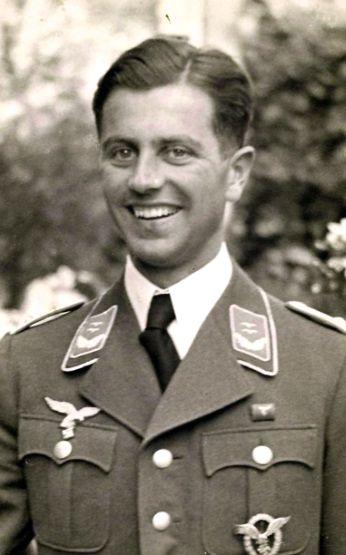
Oberleutnant Georg Schneider © Erik Fechner
L'Oberleutnant Georg Schneider est un pilote inconnu du grand public et probablement peu connu des passionnés de l'aviation de la seconde guerre mondiale. Il fut tué à bord de son avion dans les tous premiers mois de la guerre. Je me suis intéressé à ce pilote pour la simple et bonne raison qu'il était le grand-oncle maternel d'Erik Fechner, membre fondateur du forum des maquettistes "Fighters", qui m'a chaleureusement accueilli chez lui, dans le département de l'Essone, un jour d'avril 2018. Erik, maquettiste chevronné de talent, est également un contributeur assidu du diorama de la mémoire, un diorama au 1/48° représentant une base de la RAF sur laquelle sont disposés les maquettes des avions tombés en Bretagne et Loire-Atlantique pendant la seconde guerre mondiale.
Oberleutnant Georg Schneider is a pilot unknown to the public and probably little known to the Second World War aviation fans. He was killed on board his aircraft in the very first months of the war. I am interested by this pilot for the simple reason that he was the maternal great-uncle of Erik Fechner, founder and member of the model-makers forum called "Fighters", who warmly welcomed me at home, in the department of Essone (southern Paris, France), one day of April, 2018. Erik, experienced and talented model-maker, is also an active contributor for the diorama of the memory, a diorama (scale 1:48) representing a RAF base on which are displayed the models of aircrafts fallen in Brittany and Loire-Atlantique during World War II.
En quelques mots - In a few words
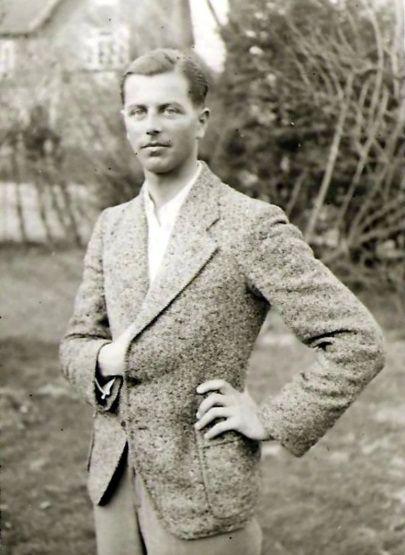
Georg Schneider © Erik Fechner
Né le 5 juillet 1913 à Marne, une petite ville du Schleswig-Holstein au nord de l’Allemagne, il est décédé peu avant ses 27 ans le 27 juin 1940 vers 17 heures en s’écrasant dans un bois à Zeist (près d’Austerlitz), à 10 km à l’est d’Utrecht aux Pays-Bas. Sa tombe est toujours en Hollande dans le cimetière militaire allemand d’Ysselsteyn (Venray / Limburg).
Born on July 5th, 1913 in Marne, a small town in Schleswig-Holstein in the North of Germany, he died shortly before his 27 years on June 27th, 1940 by 5 pm when crashing in a wood at Zeist (near Austerlitz), 6 miles from east Utrecht in the Netherlands. His grave is always in Holland in the German military cemetery of Ysselsteyn (Venray/Limburg).
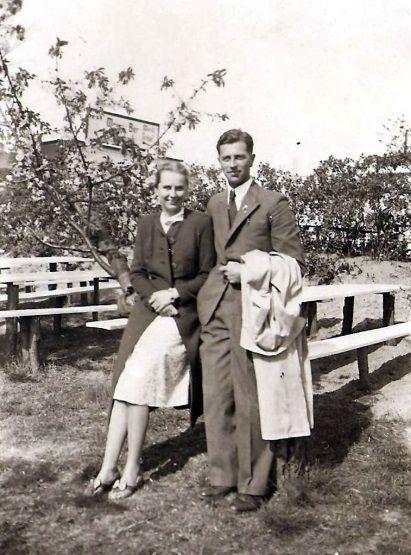
Georg Schneider © Erik Fechner
Lors de cet ultime combat du 27 juin 1940, il pilotait un Messerschmitt Bf 109 E-1, le "Gelbe 1" ("1 jaune") de la 3.Staffel - I./JG 21 – VIII. Fliegerkorps, une unité stationnée à Soesterberg (Pays-Bas) depuis le 23 juin. Georg Schneider portait le grade d’Oberleutnant de la Luftwaffe et était le Staffelkapitän (chef d’escadrille) de la 3. Staffel. Ce combat du 27 juin qui lui fut fatal, a été en même temps sa 7e victoire aérienne certifiée (probablement une 8e) depuis septembre 1939… Il a été de fait le 1er pilote de la JG 21 à avoir été abattu dans le ciel néerlandais et fut inhumé le 28 juin avec les honneurs militaires en présence de toute l’escadre au cimetière de Soesterberg. A sa suite à la tête de la 3. Staffel a été nommé l’Oberleutnant Richard Hausmann, la JG 21 disparaissant peu de temps après pour former le III./JG 54.
During this ultimate fight of June 27th, 1940, he flew a Messerschmitt Bf 109 E-1, "Gelbe 1" ("yellow 1") of 3.Staffel - I./JG 21 - VIII. Fliegerkorps, a unit based in Soesterberg (Netherlands) since June 23rd. Georg Schneider held the rank of Oberleutnant in the Luftwaffe and was Staffelkapitän (squadron leader) of 3. Staffel. This fight of June 27th which proved fatal to him, was at the same time his 7th air confirmed kill (probably an 8th) since September, 1939 … He was then the 1st pilot of the JG 21 shot down in the Dutch sky, and was buried on June 28th, with full military honours in the presence of all the squadron in the cemetery of Soesterberg. His successor at the head of 3. Staffel was Oberleutnant Richard Hausmann. The JG 21 disappeared a short time later to create the III. / JG 54.
Carrière militaire - Military career
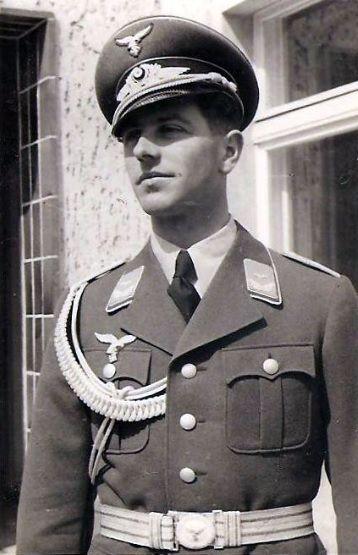
Oberleutnant Georg Schneider © Erik Fechner
L’Oberleutnant Georg Schneider était le Staffelkapitän de la 3./I./JG 21 depuis le 13 juillet 1939. La I./JG 21 s’est d’abord trouvée à Jesau (province de Königsberg – Prusse-Orientale, aujourd’hui la ville russe de Juschny, près de Kaliningrad) puis à Gutenfeld (Kreis Königsberg/Samland, Ostpreußen, aujourd’hui la ville russe de Lugowoje, près de Kaliningrad) à partir du 24 juillet 1939. A la fin de ce même mois, l’escadre reçut l’ordre de se préparer au combat.
The Oberleutnant Georg Schneider was Staffelkapitän of 3./I./JG 21 since July 13th, 1939. The I./JG 21 was at first at Jesau (region of Königsberg - Eastern Prussia, today the Russian city of Juschny, near Kaliningrad) then at Gutenfeld (Kreis Königsberg/Samland, Ostpreußen, today the Russian city of Lugowoje, near Kaliningrad) from July 24th, 1939. At the end of the same month, the squadron was ordered to get ready for the fight.
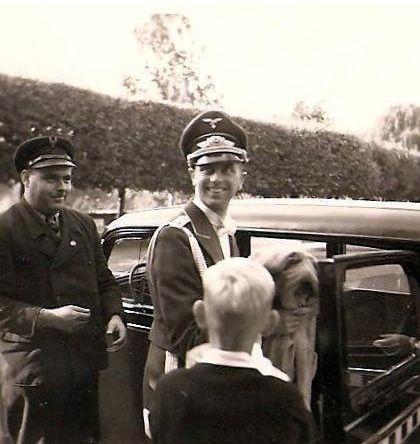
Oberleutnant Georg Schneider © Erik Fechner
L’engagement de la 3./JG 21 dans la campagne de Pologne
The involment of the 3./JG 21 in the campaign of Poland
(source : Marek J. Murawski – Messerschmitt Bf 109 C/D in the Polish Campaign 1939 – Kagero 2010)
Le 23 août 1939, l’Allemagne et l’Union soviétique ont surpris l’opinion publique mondiale en signant un pacte de non-agression. A partir de là, une offensive contre la Pologne, prise en tenaille entre ses deux puissants voisins, n’était plus qu’une question de temps. Initialement l’invasion du pays voisin était d’ailleurs prévue au 26 août 1939. Mais la signature à Londres le 25 août d’un accord d’assistance pour cinq ans entre la Pologne et la Grande-Bretagne, modifiant quelque peu l’équilibre des puissances sur le continent européen, fit hésiter Hitler qui reporta la date de l’offensive pour permettre à sa diplomatie une ultime tentative de dissuader la Grande-Bretagne et la France d’intervenir dans le conflit imminent.
On August 23rd, 1939, Germany and Soviet Union surprised the public opinion worldwide by signing a non-aggression pact. From there, an offensive against Poland, caught between its two powerful neighbors, was just a question of time. Initially the invasion of the nearby country was planned on August 26th, 1939. But the signature in London on August 25th of an assistance agreement for five years between Poland and Great-Britain, modified a little bit the balance of power on the European continent, and made Hitler hesitate. He postponed the date of the offensive to allow his diplomacy an ultimate attempt to dissuade Great Britain and France to interfer in the coming conflict.
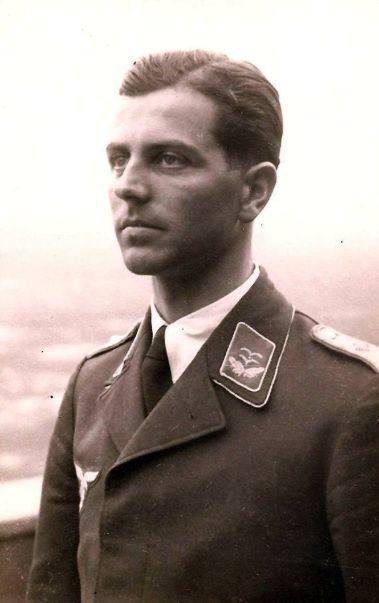
Oberleutnant Georg Schneider © Erik Fechner
Mais il était déjà trop tard pour la diplomatie. Le 31 août 1939, Hitler donne l’ordre ("Weisung Nr. 1 für die Kriegsführung") d’attaquer la Pologne dans les premières heures du 1er septembre 1939. De fait par la déclaration de guerre du Royaume-Uni et de la France à l’Allemagne deux jours plus tard en réponse à l’agression sur la Pologne, cette attaque allemande fut l’événement déclencheur de la Seconde Guerre mondiale en Europe.
But it was already too late for the diplomacy. On August 31st, 1939, Hitler gave the order ("Weisung Nr. 1 für die Kriegsführung") to attack Poland early on September 1st, 1939. With the declaration of war of the United-Kingdom and France to Germany two days later in answer to the aggression on Poland, this German attack was the triggering event of the Second World War in Europe.
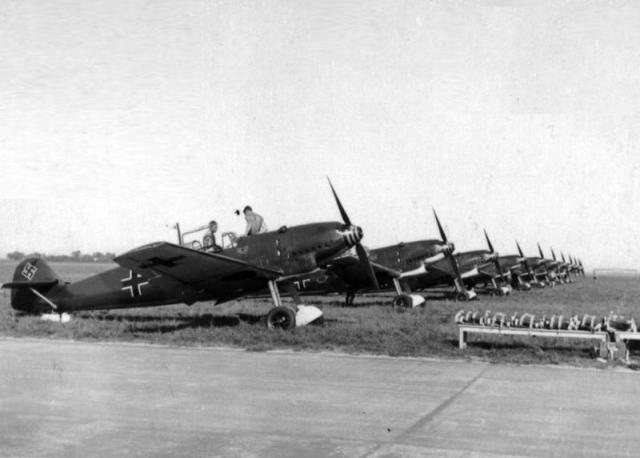
Messerschmitt Bf 109D, 3./JG 21
Photo : auteur inconnu - author unknown
La Luftwaffe a utilisé deux unités dans son offensive contre la Pologne, la "Luftflotte 1 Ost" au nord, sous le commandement du général Albert Kesselring, et la "Luftflotte 4 Südost" sous les ordres du général Alexander Löhr, au sud. Au total, la Luftwaffe a engagé un effectif théorique de 342 chasseurs Messerschmitt Bf 109 (320 en état de vol).
The Luftwaffe sent two units in its offensive against Poland, the "Luftflotte 1 Ost" in the North, under the command of general Albert Kesselring, and "Luftflotte 4 Südost" under the orders of general Alexander Löhr, in the South. The Luftwaffe committed a theoretical number of 342 fighters Messerschmitt Bf 109 (320 in flight conditions).
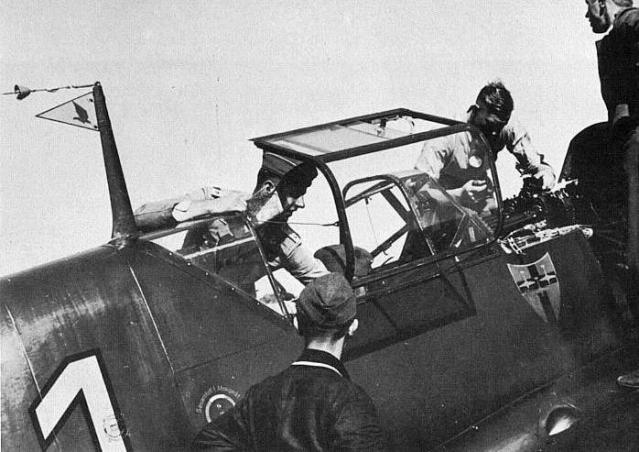
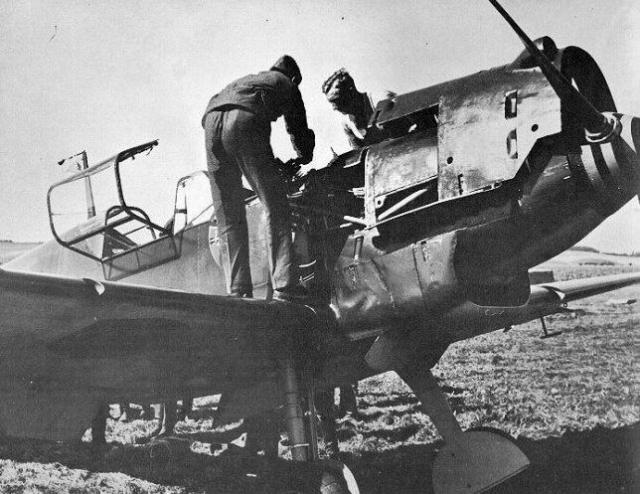

Messerschmitt Bf 109D, 3./JG 21 ("Jesau Kreuz"), Oblt. Georg Schneider
Gutenfeld, août 1939 - Gutenfeld, August, 1939
Photo : auteur inconnu - author unknown
Deux escadres étaient équipées de Messerschmitt Bf 109 D (Dora), la I./JG 21, commandée par le Hauptmann Martin Mettig, dépendante du "Luftgaukommando I Ostpreußen" au nord , et la I./ZG 2 commandée par le Hauptmann Johannes Gentzen, intégrée dans le " Fliegerführer z.b.V. " au sud .
Two squadrons were equipped with Messerschmitt Bf 109 D (Dora), the I./JG 21, led by Hauptmann Martin Mettig, depending on "Luftgaukommando I Ostpreußen" in the North, and the I./ZG 2 led by Hauptmann Johannes Gentzen, integrated into the "Fliegerführer z.b. V." in the South.
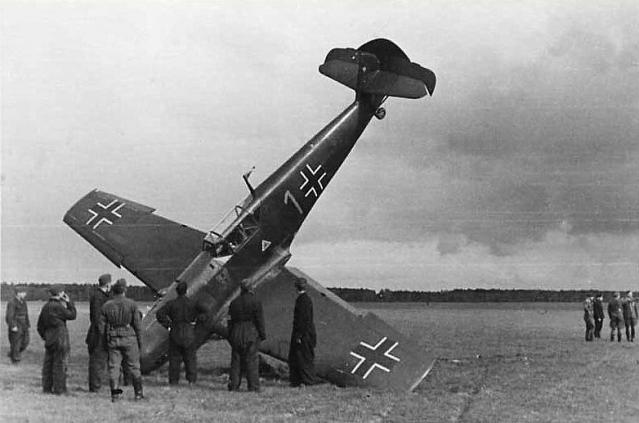
Messerschmitt Bf 109D "Gelbe 1", 3./JG 21, Oblt. Georg Schneider
Photo : auteur inconnu - author unknown


Messerschmitt Bf 109D "Gelbe 1", 3./JG 21
Auteurs inconnus - Authors unkown
Dès le 24 juillet 1939, la I./JG 21 fut déplacée sur un aérodrome de Prusse-Orientale plus proche de la frontière polonaise, à Gutenfeld (aujourd’hui : Lugowoje, près de Kaliningrad, Russie). A la date du 26 août 1939, l’escadre disposait de 39 Bf 109 D-1 répartis entre trois "Staffeln" : la 1. sous les ordres de l’Oblt. Günther Scholz, la 2. sous ceux de l’Oblt. Leo Eggers et la 3. sous ceux de l’Oblt. Georg Schneider. A la même date, la I./ZG 2 était basée à Groß-Stein en Haute-Silésie avec 45 Bf 109 C et D, répartis sur 3 Staffeln également.
On July 24th, 1939, the I./JG 21 was moved on an airfield in Eastern Prussia, closer to the Polish border, at Gutenfeld (today : Lugowoje, near Kaliningrad, Russia).On August 26th, 1939, the squadron was equipped with 39 Bf 109 D-1 splited in three "Staffeln" : the 1. under the orders of Oblt. Günther Scholz, the 2. led by Oblt. Leo Eggers and the 3. under the orders of Oblt. Georg Schneider. The same day, the I./ZG 2 was based at Groß-Stein in Upper-Silesia with 45 units of Bf 109 C and D, splited also in 3 Staffeln.
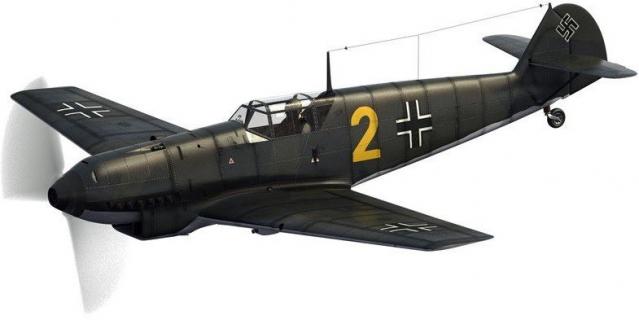
Messerschmitt Bf 109D "Gelbe 2", 3./JG 21
Artist inconnu - artist unknown
Les ordres opérationnels (opération "Wasserkante") pour la I./JG 21 sont arrivés à Gutenfeld vers 18h00 le 31 août 1939 : décollage à 4h30 le lendemain pour une mission d’escorte de bombardiers en direction de Varsovie. Mais les conditions météorologiques (d’épaisses nappes de brouillard se formant durant la nuit) ont finalement entraîné l’annulation de cette mission. Ce n’est qu’à 8h02 que les appareils de la 1. Staffel ont pu décoller en direction de la ville allemande d’Insterburg (aujourd’hui la ville russe de Tcherniakhovsk) où des postes d’observation avaient cru entendre le bruit d’avions non identifiés. Patrouillant pendant 20 minutes au-dessus de la ville et constatant un ciel vide d’avions, les appareils sont retournés à Gutenfeld dans la matinée encore.
The operational orders (operation "Wasserkante") for I./JG 21 arrived at Gutenfeld by 6:00 pm on August 31st, 1939 : take-off at 4:30 am the next day for an escort mission with bombers towards Warsaw. But the weather conditions (fog formed during the night) finally involved the cancellation of this mission. At 8:02 am only, the aircrafts of 1. Staffel were able to take off heading the German city of Insterburg (today the Russian city of Tcherniakhovsk) where observation posts had believed they heard the noise of unidentified aircrafts. Flying during 20 minutes over the city and noting that the sky was empty, the aircrafts flew back to Gutenfeld again in the morning.
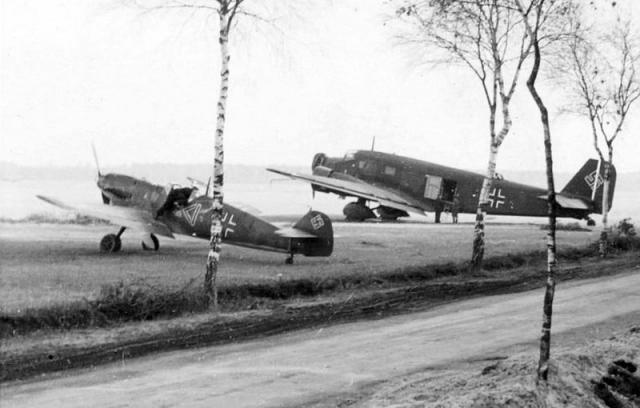
La I./JG 21 à Arys-Rostken - The I./JG 21 at Arys-Rostken
Photo : auteur inconnu - author unknown
La I./JG 21 a reçu l’ordre après le déjeuner de se déplacer vers un aérodrome de campagne ("Feldflugplatz") tout près de la frontière, celui d’Arys-Rostken , quelques 130 kilomètres plus au sud. Les Bf 109 D ont décollé de Gutenfeld à 14h20 et se sont posés sur leur nouvelle base une demi-heure plus tard, un avion de transport Ju-52/3m les suivant peu après avec les mécaniciens et les armuriers de l’unité.
The I. / JG 21 was ordered after the lunch to move towards a campaign airfield ("Feldflugplatz") very close to the border, called Arys-Rostken, some 80 miles further south. Bf 109 Ds took off from Gutenfeld at 2:20 pm and landed on their new base half an hour later. A transport aircraft Ju-52/3m followed them shortly after with the mechanics and armourers of the unit.
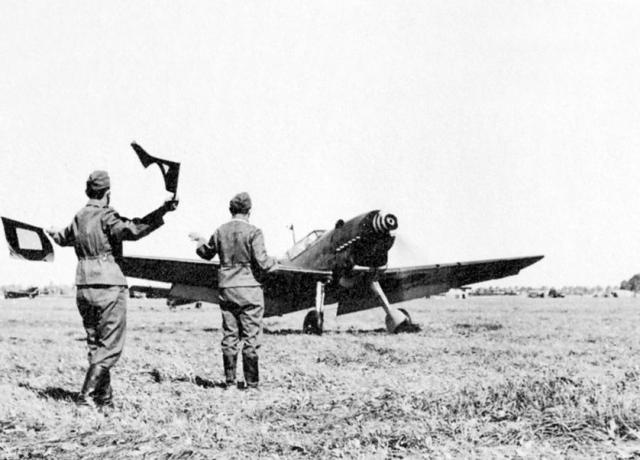
Messerschmitt Bf 109D "Gelbe 1", 3./JG 21, Oblt. Georg Schneider
Photo : auteur inconnu - author unknown
Lors de l’atterrissage à Arys–Rostken, le Bf 109 D du caporal Johannes Rauhut (1. Staffel) dut se poser sur le ventre suite à une défaillance du train et son appareil fut endommagé à 30%. Après le ravitaillement, 30 Bf 109 D ont décollé à 16h16 pour couvrir une formation de bombardiers He 111 (KG 27 et LG 1) et Ju 87 (I./St .G 1.) en direction des installations militaires dans et autour de la ville de Varsovie. Ce fut une tâche extrêmement difficile car la capitale polonaise se situait à la limite du rayon d’action des chasseurs.
When landing at Arys-Rostken, the Bf 109 D of corporal Johannes Rauhut (1. Staffel) operated a belly landing further to a failure of the landing gear and the aircraft was damaged at 30 %. After refuelling, 30 Bf 109 Ds took off at 4:16 pm to cover a group of He 111 bombers (KG 27 and LG 1) and Ju 87 (I./St .G 1.) flying towards the military installations in and around the city of Warsaw. It was a very difficult duty according to the fact that the Polish capital was located at the limit of the fighters' range.
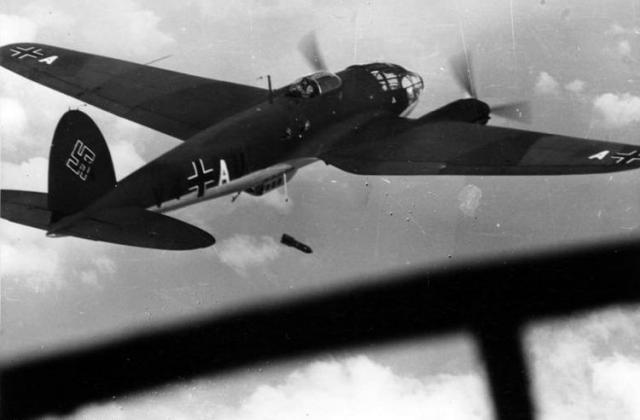
Heinkel He 111 "V4+AU", KG 1
bombardant la Pologne, septembre 1939 - dropping bombs over Poland, September 1939
© Bundesarchiv Bild 101I-317-0043-17A
(Cette image est soumise aux droits de Creative Commons Attribution ShareAlike 3.0 Germany License)
(This picture is licensed under Creative Commons Attribution ShareAlike 3.0 Germany License)
Lt. Hans-Ekkehard Bob, pilote de la 3. Staffel sous les ordres de Georg Schneider
Lt. Hans-Ekkehard Bob, pilot of 3. Staffel under the orders of Georg Schneider
(entretien avec Marek J. Murawski, le 25 août 2007 - interview with Marek J. Murawski, 25th August, 2007)
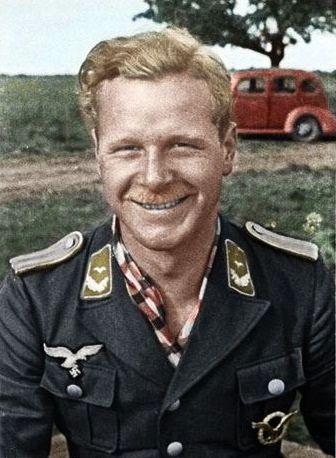
Lt. Hans-Ekkehard Bob
Photo : source et auteur inconnus - source and author unknown
" En début d’après midi, les trois "Staffeln" de notre "Gruppe" ont décollé de Arys-Rostken et se sont dirigées vers Varsovie. Notre tâche était de fournir une couverture pour les Heinkel He 111 de la KG 27. Quand nous sommes arrivés au point de rendez-vous, leurs mitrailleurs ont ouvert sur nous un feu nourri et chaotique. Nos camarades nous prenaient pour des Polonais! Apparemment, ils ne savaient pas que notre ennemi ne disposait pas de chasseur moderne monoplan à aile basse avec train d’atterrissage rétractable. N’ayant aucun contact radio avec les bombardiers, notre commandant, le Hauptmann Martin Mettig, se résolut à tirer un signal d’identification préétabli, une fusée blanche qui, à l’éclatement, libérait trois étoiles rouges supplémentaires.
" Early in the afternoon, three "Staffeln" of our "Gruppe" took off from Arys-Rostken and flew towards Warsaw. Our duty was to protect Heinkel He 111s of KG 27. When we arrived at the meeting point, their machine gunners opened fire on us. Our companions thought we were Polish ! Apparently, they did not know that our enemy had no modern monoplane low wing fighter with retractable landing gear. Because of a lack of radio contact with bombers, our commander, Hauptmann Martin Mettig, decided to send an identification signal, a white flare which, when explosing, released three additional red flares.
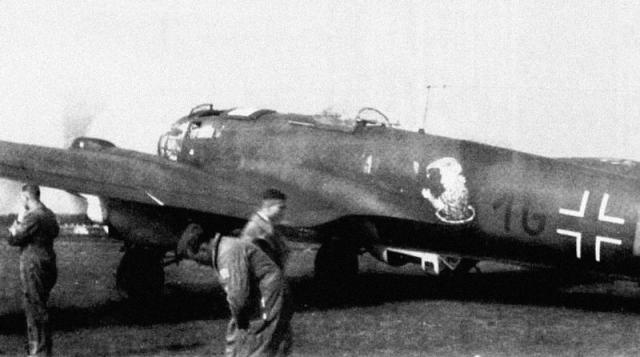
Heinkel He 111P2 "1G + EK", 3.KG27, 1939
Photo : source et auteur inconnus - source and author unknown
Le pistolet de cette fusée était fixé sur le côté tribord de la paroi du cockpit, juste en-dessous de la verrière. La fusée devait jaillir sur l’extérieur par le canon percé dans la paroi. Il a du être obstrué par quelque chose, car – comme notre commandant nous l’a dit plus tard – lorsque il a appuyé sur la gâchette, la fusée a explosé dans sa culasse et est revenue dans le cockpit ! Le commandant a subi de graves brûlures à la main droite. La fusée bourdonnait furieusement à l’intérieur du cockpit, rebondissant sur les parois latérales et la verrière …
The pistol of this flare was fitted on the right side of the cockpit, just below the canopy. The flare was supposed to exit from the canon drilled in the fuselage. But it was probaly blocked by something, because - as our commander told us later - when he pulled the trigger, the flare exploded in its cylinder and returned in the cockpit ! The commander was seriously burned on the right hand. The flare buzzed furiously inside the cockpit, bouncing on the side walls and the canopy…
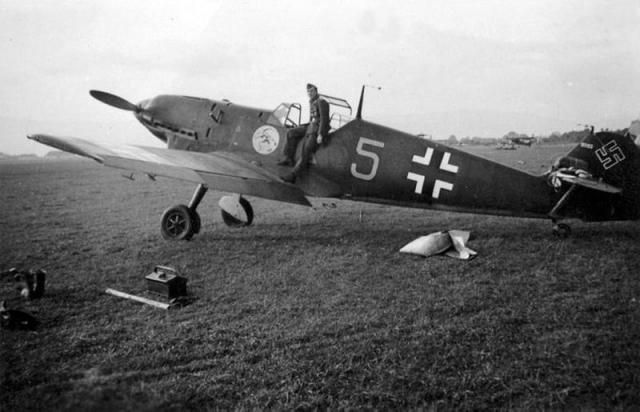
Messerschmitt Bf 109D-1
Photo : source et auteur inconnus - source and author unknown
Après un certain temps, elle a semblé avoir fini de se consumer lorsqu’elle s’est enflammée de nouveau, déclenchant l’explosion des trois feux rouges ! Le commandant, étouffé par la fumée, a largué la verrière pour laisser les feux rouges jaillir à l’extérieur. Gravement brûlé, il est retourné à la base accompagné de son ailier, l’Oblt. Schelcher et de l’autre "Rotte" (littéralement le "gang", la 2ème paire d’avions de "l’essaim" – le "Schwarm" selon la stratégie élaborée par Werner Mölders et Günther Lützow durant la guerre d’Espagne) de son "Stabsschwarm".
After a while, it seemed to be totally burned but it ignited again, involving the explosion of three red lights ! The commander, chocked by the smoke, released the canopy to let the red lights spring outside. Seriously burned, he returned to the base accompanied by his wingman, Oblt. Schelcher and by the other "Rotte" (literally the "gang", the 2nd pair of aircrafts of "the swarm" - the "Schwarm" according to the strategy elaborated by Werner Mölders and Günther Lützow during the Spanish War) of his "Stabsschwarm".
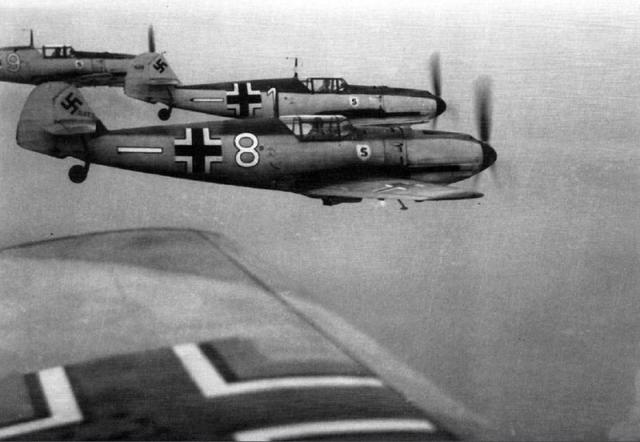
Messerschmitt Bf 109E
Un Schwarm de 4 avions - A Schwarm with 4 aircrafts
Photo : source et auteur inconnus - source and author unknown
Les autres appareils de notre "Gruppe" ont continué sur Varsovie, se maintenant à une certaine distance de sécurité de nos bombardiers qui continuaient à nous considérer comme des avions hostiles et lâchaient opiniâtrement des rafales en notre direction. À l’approche de Varsovie, nous avons repéré quelques chasseurs polonais PZL P.24 approchant de notre formation de bombardiers (tous les pilotes de la Luftwaffe engagés dans l’offensive sur la Pologne ont invariablement confondu les chasseurs PZL P.11, équipés de l’aile de mouette dite « Pulawski » avec des PZL P.24 alors qu’en réalité, cette série 24, la plus moderne de ces chasseurs n’a pas été utilisée par l’armée de l’air polonaise).
Other aircrafts in our "Gruppe" went on flying towards Warsaw, but remained at a safe distance from our bombers which kept considering us as hostile aircrafts and shot regular bursts in our direction. When approaching Warsaw, we located some Polish fighters PZL P.24 flying towards our bombers (every pilot of the Luftwaffe involved in the offensive on Poland invariably confused fighters PZL P.11, equipped with "gull" wings called "Pulawski", with PZL P.24 while in fact, this 24 series, the most modern of these fighters, was not used by the Polish Air Force).
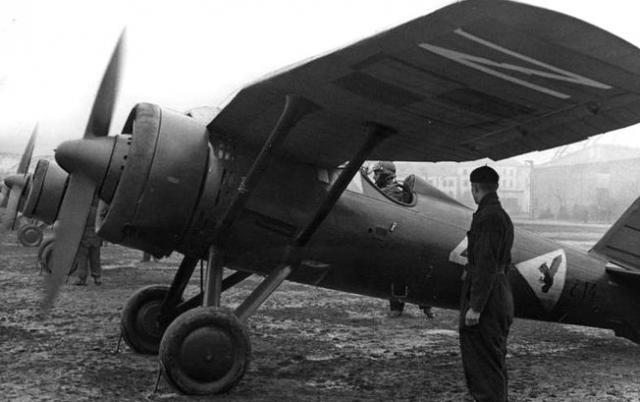
PZL P11.C, 1939 - Varsovie - Warsaw
Photo : © Polish National Digital Archive domaine public - public domain
Un duel féroce s’en est ensuivi, qui a rapidement éclaté en une série de duels individuels. Notre formation était dispersée partout dans le ciel. Nous avons fixé les chasseurs polonais pour libérer le passage de nos Heinkel vers leur cible. Mais ces duels aériens nous ont amenés au-dessus de Varsovie, à la dangereuse limite de notre rayon d’action. Ne pouvant attendre un regroupement de l’escadrille, chacun est rentré par ses propres moyens à Arys-Rostken. Nos jeunes "bleus", dont c’était aussi la première mission de combat, furent rapidement désorientés.
An important fight started, which quickly switched to individual fights. Our group was splitted everywhere in the sky. We kept by us the Polish fighters to let our Heinkel fly towards their target. But these dog fights led us over Warsaw, in the dangerous limit of our range. Because we could'nt wait for a squadron gathering, each of us flew back alone to Arys-Rostken. Our young pilots, for whom it was also the first fight mission, were rapidly disorientated.
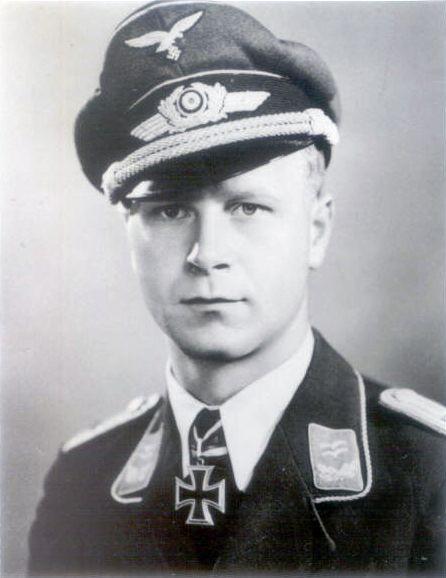
Lt. Hans-Ekkehard Bob
Photo : source et auteur inconnus - source and author unknown
Pour ma part, après quelques cercles pour localiser ma position, je pus virer pour rentrer à la base. Je fus le premier pilote de la 3. Staffel à se présenter au-dessus d’Arys-Rostken où j’atterris sur les "charbons ardents" peu avant 18 h. Notre Staffelkapitän, l’Oblt. Schneider, a dû atterrir ailleurs pour faire le plein et est revenu dans la soirée.
As for me, after some circles to check my position, I could turn to fly back to the base. I was the first pilot of 3.Staffel to fly over Arys-Rostken where I landed on "tenterhooks" shortly before 6 pm. Our Staffelkapitän, Oblt. Schneider, had to land somewhere else to refuel and returned in the evening.

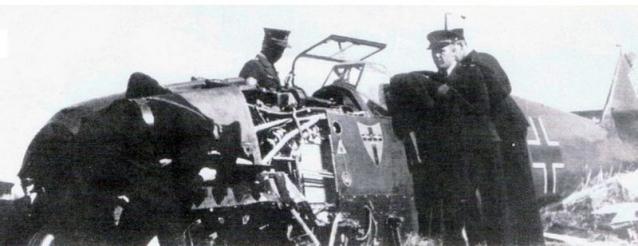
Messerschmitt Bf 109D, 3./JG 21
Le "Gelbe 8", égaré et à court de carburant, a dû se poser en Lituanie - The "Gelbe 8" got lost, ran out of fuel and had to land in Lithuania.
Photo : source et auteur inconnus - source and author unknown
Sur l’ensemble des huit appareils de la 3. Staffel, deux seulement ont pu revenir directement, les six autres ont fait des atterrissages d’urgence sur le vol du retour. Je me souviens que les Polonais ont capturé deux pilotes et qu’un autre a été interné en Lituanie. Heureusement, ils sont tous retournés en service à l’issue de la campagne de Pologne. "
Out of the eight aircrafts of 3.Staffel, two only could fly back directly, the six others made emergency landings on their way back. I remember that the Poles captured two pilots and that another one was put in jail in Lithuania. Fortunately, they all returned to service at the end of the campaign of Poland. "
Caporal Walter Nuhn, pilote de la 2. Staffel, combats sur Varsovie le 1er septembre 1939
Corporal Walter Nuhn, pilot of 2. Staffel, dogfights over Varsaw, 1st September, 1939
" Le "Gruppe" fut lancé dans l’ordre suivant : 1., 2. puis 3. Staffel. Ma 2. Staffel décolla avec 10 appareils – deux "Schwärme" et un "Rotte" supplémentaire, formé par le Lieutenant Schön et moi-même. Les conditions météo étaient nettement défavorables pour la tâche à accomplir, en raison surtout de la mauvaise visibilité. Le vol vers Varsovie se déroula sans incident, jusqu’à ce que nous tombions sur les chasseurs ennemis à environ 20 km au nord de la ville. Dès que nous les avons vus, la Staffel fondit à l’attaque. Une mêlée sauvage s’est engagée. J’ai fait de mon mieux pour rester aux côtés du Lieutenant Schön.
" The Gruppe scrambled in the following sequence: Stab, 1st, 2nd and 3rd Staffel. My 2nd Staffel went up with ten machines – two Schwärme and one extra Rotte, formed by Lt. Schön and myself. Weather conditions were decidedly unfavourable for the task at hand, due especially to the poor visibility. The trip to Warsaw was uneventful, until we ran into enemy fighters some 20 km north of the city. As soon as we saw them, the Staffel swooped down to attack. A wild melee developed. I did my best to stick to Lt. Schön.
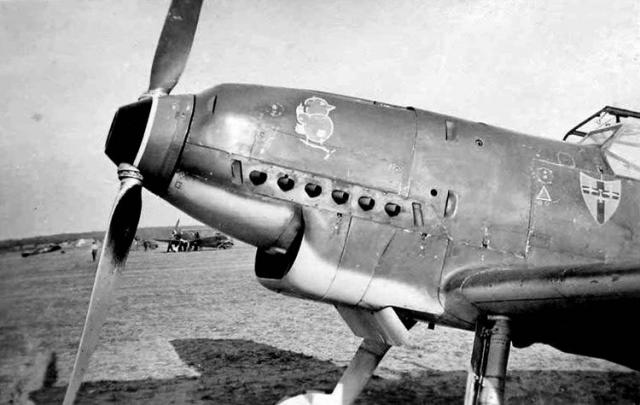
Messerschmitt Bf 109 D-1, 2./JG 21
Photo : source et auteur inconnus - source and author unknown
Nous avons isolé deux chasseurs et les avons engagés. Ils ont tous deux viré autour de nous afin de nous rencontrer de front. Soudain, l’un d’eux a surgi juste en face de moi. Nous avons ouvert le feu au même instant. Quand j’ai rompu le combat, je me suis aperçu que nous nous étions égarés au-dessus de Varsovie. J’ai aperçu un seul PZL 24 à proximité et l’ai poursuivi. Il a été à portée de tir seulement quelques secondes puis il est reparti. Entre-temps, j’étais plus préoccupé par le barrage anti-aérien des multiples positions qui entouraient la ville. Dans un premier temps, les éclats de la "Flak" (polonaise) pouvaient être aperçus en-dessous mais plus tard, les explosions de suie noire ont commencé à surgir tout autour de nous, dangereusement près.
We singled out two fighters and engaged them. They both veered around to meet us head-on. Suddenly, one of them loomed large right in front of me. We opened fire at the same instant. As I broke off, I realized that we had strayed over Warsaw. I saw a single PZL 24 nearby and set upon him. She was in range only for a split second, and then he was gone. By then I had become more concerned about the anti-aircraft barrage from the multiple guns that ringed the city. At first, (Polish) "Flak" bursts could be seen below, but then the sooty puffs began to pop up all around us, dangerously close.
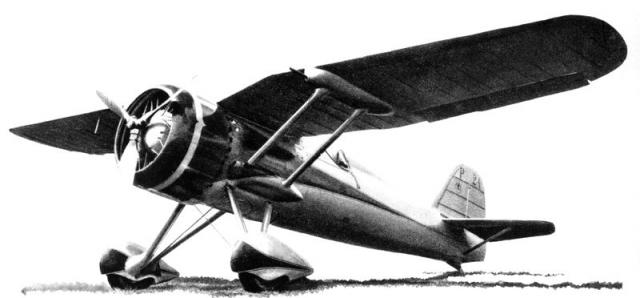
PZL P24, prototype
Photo : domaine public - public domain
Je pouvais voir nos combattants, chasseurs et bombardiers sur Varsovie. Ici et là, des chasseurs ennemis isolés se mêlaient à eux. Pour la troisième fois ce jour-là, j’ai eu la vision d’un chasseur PZL dans mon collimateur. J’ai ouvert le feu et mon adversaire s’est esquivé dans les nuages. Ensuite, je me suis retrouvé tout seul. Heureusement, je remarquai sous moi une formation de He 111 et les ai suivis. Je les accompagnais jusqu’à un point à environ 10 km au nord de Varsovie, d’où ils ont viré vers l’ouest tandis que je continuai vers le nord. Je n’ai aperçu aucun de nos chasseurs sur le vol du retour. J’ai attendu en vain jusqu’à 17h25 au dessus de la confluence de la Narew et de la Bug, puis ai pris le cap du retour.
I could see our fighters, Zerstörern and bombers over Warsaw. Here and there, single enemy fighters tangled with them. For the third time that day I caught a glimpse of a PZL fighter in my gunsight. I opened fire and my adversary ducked into the clouds. Then I found myself all alone. Luckily, I spotted a formation of He 111s below and tagged along. I accompanied them to a point some 10 km north of Warsaw, where they turned west, and I continued north. I didn’t see any of our fighters on my way back. I waited in vain until 5:25 pm over the confluence of the Narew and Bug rivers, then picked up the heading home.
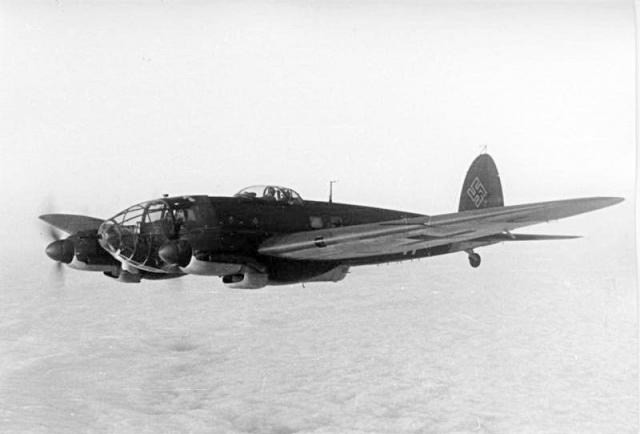
Heinkel He 111
© Bundesarchiv Bild 101I-647-5211-33 Photographer : Wilzek
(Cette image est soumise aux droits de Creative Commons Attribution ShareAlike 3.0 Germany License)
(This picture is licensed under Creative Commons Attribution ShareAlike 3.0 Germany License)
J’ai volé le long de la rivière Narew jusqu’à Ostrołęka. Là, j’ai changé le cap de 20 degrés et au-dessus de Gnesen, j’ai franchi la frontière. De là, je ne savais pas où aller, j’ai piqué pour jeter un œil sur la gare ferroviaire la plus proche mais je ne l’ai pas trouvée sur ma carte. En suivant une voie ferrée étroite, je suis arrivé au-dessus de Johannisburg d’où j’ai volé jusqu’à Arys. J’ai raté l’aérodrome la première fois et suis retourné à Johannisburg. Enfin, j’ai pu repérer l’aérodrome, où je me suis posé à 18h00. Le voyant de réserve de carburant était allumé depuis 28 minutes ".
I flew along the Narew river as far as Ostrołęka. There, I changed the course to 20 degrees and at Gnesen I crossed the border. From there I didn’t know where to go, hence I dropped down to have a look at the nearest railway station, but then I couldn’t find it on my map. Following a narrow gauge railway track, I reached Johannisburg, and flew on to Arys. I missed the airfield the first time, and turned back to Johannisburg. Finally, I spotted the airfield, where I landed at 6:00 pm. The fuel warning lamp had been glowing for 28 minutes”.
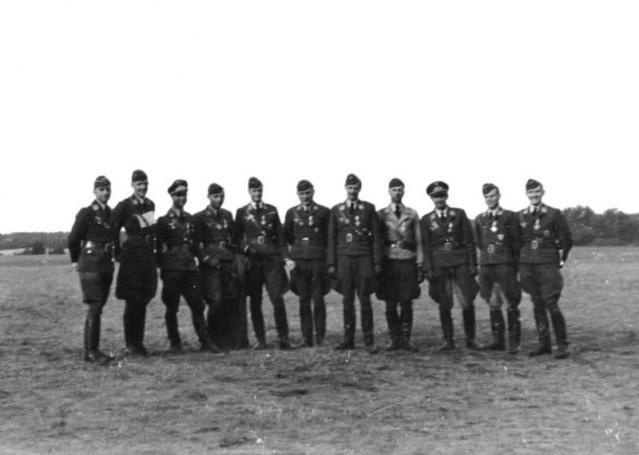
Arys-Rostken, 17 septembre 1939, pilotes de la JG 21, 17th September, 1939, pilots of JG 21
De gauche à droite - from left to right : Hptm. Martin Mettig (Commander JG 21), Lt. Ekkehard Schelcher (1. Staffel), Lt. Hans-Ekkehard Bob (3. Staffel), Lt. Anton Schön (2. Staffel), Lt. Adolf von Boeselager (1. Staffel), Lt. Gustav Rödel (2. Staffel), Oblt. Leo Eggers (Commander 2. Staffel ), Oblt. Georg Schneider (Commander 3. Staffel), Oblt. Günther Scholz (Commander 1. Staffel) , Lt. Ernst Ewers (1. Staffel), Lt. Heinz Lange (1. Staffel)
Photo : auteur inconnu - author unknown
A l’issue des combats aériens au-dessus de Varsovie, les pilotes de la I./JG 21 revendiquèrent 5 victoires sur les chasseurs polonais PZL dont 4 furent confirmées. Ces victoires furent portées au crédit du Lt. Fritz Gutezeit de la 3./JG 21 (vers 16h55, dans la région de Varsovie), du Lt. Gustav Rödel de la 2./JG 21 (à 17h08, dans la région de Varsovie), de l’Oblt. Georg Schneider de la 3./JG 21 (à 17h10 au dessus de Marki, au nord-est de Varsovie) et de l’Uffz. Heinz Dettmer de la 3./JG 21 (à 17h19, au nord de Varsovie). La demande présentée par l’Oblt. Albrecht Dresz de la 2./JG 21 fut rejetée. En effectuant des recherches sur ces revendications,l’historien de la Luftwaffe Marius Emmerling, aboutit plutôt à la conclusion que c'est l'Oblt. Georg Schneider de la 3./JG 21 qui abattit le P.11 PZL du Capitaine Gustaw Sidorowicz de la 9e escadrille de la 113e escadre de chasse polonaise (113 Eskadra Myśliwska).
During the scrap over Warsaw pilots of I./JG 21 claimed 5 Polish PZL fighters, of which 4 were later confirmed. Victories were credited to Lt. Fritz Gutezeit of 3./JG 21 (at 4:55 pm, in the Warsaw area), Lt. Gustav Rödel of 2./JG 21 (at 5:08 pm, in the Warsaw area), Oblt. Georg Schneider of 3./JG 21 (at 5:10 pm over Marki, north-east of Varsaw), and Uffz. Heinz Dettmer of 3./JG 21 (at 5:19 pm, north of Warsaw). The claim submitted by Oblt. Albrecht Dresz of 2./JG 21 was disallowed. When researching this account, the Luftwaffe historian Marius Emmerling came to the conclusion that it was Oblt. Georg Schneider of 3./JG 21 who had shot down the PZL P.11 flown by Captain Gustaw Sidorowicz of the 9th Squadron of 113th Polish Fighter Group (113 Eskadra Myśliwska).
Le Capitaine Gustaw Sidorowicz se souvient !
Captain Gustaw Sidorowicz remembered !
(Kurowski Adam, Bijcie się z nami Messerschmitty!, Warszawa 1967, pp. 90-91).
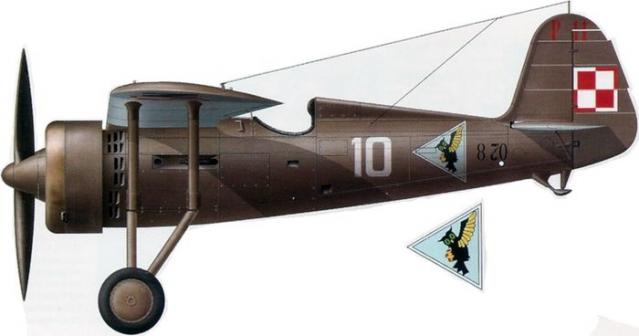
PZL P.11C, n°8.70/170-N, Podporucznik Hieronim Dudwai, 113 Eskadra Myśliwska
Varsovie - Okecie, 1er septembre 1939 - Varsaw - Okecie, 1st September, 1939
© Jean-Marie Guillou
" Tout d’un coup, volant à une altitude de 2000 mètres, j’ai repéré deux Messerschmitt au dessus de Praga (un arrondissement historique de Varsovie, situé sur la rive est de la Vistule). J’avais l’avantage de l’altitude et j’ai décidé d’aller vers eux. J’ai surgi d’un cumulus et, arrivé à courte portée, j’ai lâché une salve sur l’un des 109. Malheureusement, mes deux ailiers étaient en retard, ce qui a permis à l’autre 109 de virer vers moi et de m’envoyer une rafale bien ajustée. Le chasseur sur lequel j’avais tiré dégageait de la fumée et plongeait sur un angle raide. Je ne pouvais pas suivre sa descente et au même instant, les munitions sous mes pieds, touchées par l’autre Allemand, ont commencé à exploser.
" Suddenly, flying at an altitude of 6,500 feet, I spotted two Messerschmitts over Praga (an historical borough of Warsaw, located on the east bank of the Vistula river). I had the advantage of altitude and decided to fly in their direction. I darted out of a cumulus cloud, and when at close range, I shot a burst at one of the 109s. Unfortunately, my two wingmen were late, which enabled the other 109 to turn inside me and shoot a well-aimed burst. The fighter I had fired released smoke and dived at a steep angle. I couldn’t follow his descent, and at the same time the ammunition under my feet, hit by the other German, began to explode.
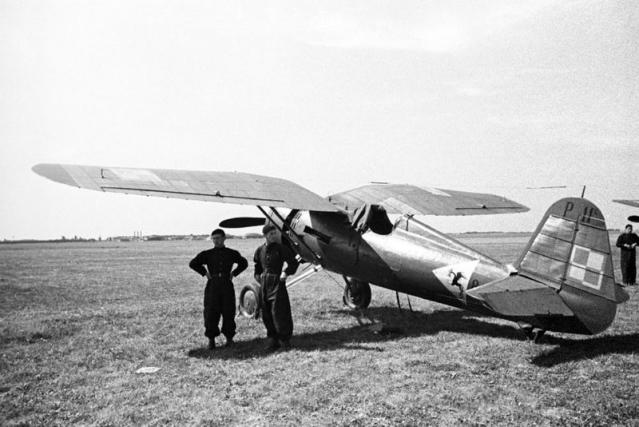
PZL P11C, 112 Eskadra Myśliwska
Photo : domaine public - public domain
Je voulais me battre mais mes mitrailleuses étaient inutilisables, les bandes de munitions déchirées. Je réalisais également que mon avion était en feu. De plus, j’étais de nouveau attaqué. Fort heureusement, il y avait un banc de nuages à proximité. Je plongeais à droite et me laissais tomber dans un nuage peu épais. Je me suis senti un instant soulagé. Contre tout espoir, j’ai tenté de me débarrasser de mes assaillants et d’éteindre les flammes qui surgissaient quelque part sous le fuselage en plongeant vers le sol.
I wanted to fight on, but my guns were not working, the ammunition belts had been ripped apart. I realized that my machine was on fire. I was still under attack. Most fortunately, there was a bank of clouds nearby. I curled off to the right and dropped into a thin cloud. I felt a momentary relief. I hoped against hope to shake off the assailants and quench the flames, which were streaming out from some spot under the fuselage and dived.
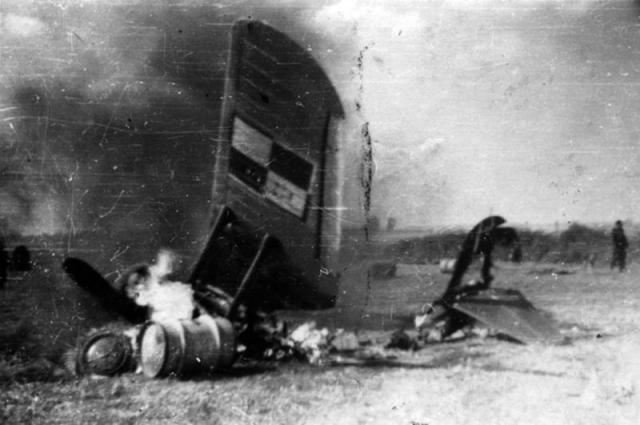
PZL P11C, abattu par Me 109, shot down by a Me 109
Photo : domaine public - public domain
De fait, les flammes ont semblé s’éteindre mais lorsque je suis sorti des nuages, j’ai été immédiatement de nouveau attaqué. Cette fois-ci, le 109 a touché mon aile droite. J’ai plongé vers le sol, à la recherche de la protection de notre artillerie anti-aérienne. Ma machine était en feu. J’étais déjà trop bas pour pouvoir sauter en parachute. J’ai franchi la Vistule, en direction de Gocław. Le moteur s’est coupé et je me suis préparé pour un atterrissage forcé. J’ai d’abord accroché une clôture de fer qui a cisaillé le train d’atterrissage fixe puis je me suis posé sur le ventre. Quelques habitants ont couru vers moi et m’ont aidé à sortir du cockpit. J’étais couvert de blessures et j’avais des brûlures. Je fus évacué à l’hôpital. "
The flames indeed seemed to die down, but when I dropped out of the cloud, I was instantly attacked. This time the 109 hit my starboard wing. I dived straight down, seeking the protection of our anti-aircraft artillery. My machine was ablaze. It was already too low to bail out. I crossed the Vistula, heading for Gocław. The engine stopped, and I prepared myself for a dead-stick landing. First I clipped an iron fence which sheared off the fixed landing gear, then I made a belly landing. Some locals ran up to me and helped me climb out of the cockpit. I was badly battered and had some burns. I was rushed to hospital ".
Le dernier combat !
The last fight !

Messerschmitt Bf 109 D-1, Lt. Gunter Scholz - 1./JG 21, Gutenfeld,
1er septembre 1939, 1st September 1939
© Pierre-André Tilley
Du côté allemand, les pertes furent également conséquentes. Les Lt. Friedrich Behrens et l‘Uffz. Otto Wolz de la 1./JG 21 durent faire des atterrissages forcés en raison de blessures durant les combats au-dessus de Varsovie et furent capturés. Le Lt. Behrens ne put retourner en Allemagne qu’après la cessation des hostilités, le 6 octobre 1939. L’Uffz. Wolz n’a pu quitter l’hôpital pour reprendre le service que le 12 novembre 1939. Le Lt. Rudolf Heimann de la 2./JG 21 à court de carburant a du se poser sur le ventre sur le territoire polonais. Fait prisonnier, il n’a été libéré que le 6 octobre. Deux autres pilotes ont connu le même sort dans la 3./JG 21 ; le Lt. Fritz Gutezeit forcé de se poser à court de carburant dans les environs de Suwałki tout comme l’Uffz. Heinz Dettmer près de Augustów.
The German unit’s own losses were also important. Lt. Friedrich Behrens and Uffz. Otto Wolz of 1./JG 21 both force-landed due to combat injuries during dogfights over Warsaw and were captured. Lt. Behrens returned to Germany after the cessation of hostilities, on 6th October 1939. The Uffz. Wolz left hospital and returned to service on 12th November 1939. Lt. Rudolf Heimann of 2./JG 21 ran out of fuel and had to belly-land in Polish territory. He was captured, and was released only on 6th October. The same fate was shared by two other pilots of 3./JG 21 ; Lt. Fritz Gutezeit was forced down out of fuel around Suwałki, as was Uffz. Heinz Dettmer near Augustów.

Messerschmitt Bf 109 D-1, 1./JG 21, Arys-Tostken
Septembre 1939, September 1939
Artiste inconnu - Artist unkown
Le caporal Werner Ahrendt de la 3./JG 21 s’est égaré vers la Lituanie où il a été interné jusqu’au 6 octobre. Au total, cinq pilotes allemands ont été contraints d’atterrir derrière les lignes polonaises et furent capturés tandis le sixième a donc été fait prisonnier en Lituanie. D’autres estimations des pertes de ce "1.Gruppe“ (composé de la seule JG 21) établissent le nombre de 11 avions perdus en raison sans doute de l’inexpérience des pilotes et du rayon d’action trop ambitieux des Bf 109-D ce jour-là.
Gefr. Werner Ahrendt of 3./JG 21 lost himself as far as Lithuania, where he was interned until 6th October. Overall, five German pilots were forced to land behind the Polish lines and were captured, whilst a sixth one was interned in Lithuania. Other estimations of the "1.Gruppe’s" losses (composed only by JG 21) indicates a number of 11 aircrafts lost, due both to a lack of experience of pilots and an over-ambitious extension of the Bf 109 D-1’s operational range.
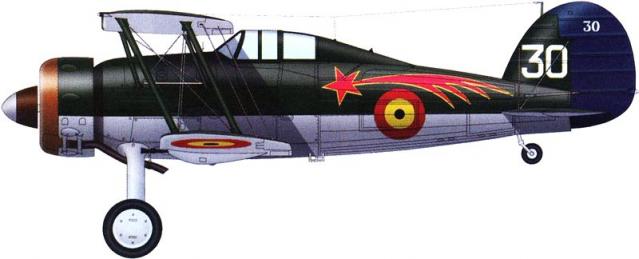
Gloster Gladiator Mk I, 1e Escadrille, 1er Groupe, 2e Régiment Aéronautique "La Comète"
Schaffen, Belgique, 10 mai 1940 - Schaffen, Belgium, May 10th, 1940
© Pierre-Andre Tilley
Dans les jours qui suivirent, les avions de la JG 21 se trouvèrent affectés aux missions d’appui des troupes au sol. Le 7 septembre 1939, Schneider abattit un deuxième PZL P. polonais à 72 km au NNO de Varsovie, dans le secteur de Ciechanow. En octobre - novembre 1939, les Messerschmitt Bf 109-D sont remplacés par des nouveaux Bf 109-E. A l’issue du conflit germano-polonais, la 3.Staffel fut rapatriée à Mönchengladbach d’où elle fut engagée à partir du 10 mai 1940 sur le front occidental. Ce jour-là, Georg Schneider obtint alors sa 3e victoire contre un Gloster Gladiator belge près de Tongeren au NO de Liège (1ères victoires pour deux de ses ailiers, Hans-Ekkehard Bob et Leykauf).
During the following days, the aircrafts of the JG 21 were assigned to the support missions for the troops in the field. On September 7th, 1939, Schneider shot down a second Polish PZL P. 45 miles NNW of Warsaw, in the sector of Ciechanow. In October-November, 1939, Messerschmitt Bf 109-Ds were replaced by new Bf 109-Es. At the end of the German-Polish conflict, the 3.Staffel returned to Mönchengladbach from where it was sent from May 10th, 1940 on the western front. This day, Georg Schneider obtained his 3rd air kill with a Belgian Gloster Gladiator near Tongeren in NW of Liège (1st kills also for two of his wingmen, Hans-Ekkehard Bob and Leykauf).
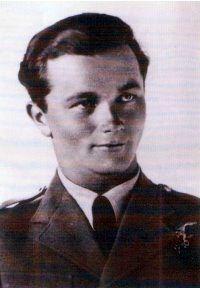
Kazimierz Augustyn Jozef BURSZTYN, GC III/1
Abattu le 25 mai 1940 à bord du MS 406 n°1047 (immat. L-637) par Georg SCHNEIDER.
Shot down on 25th May, 1940, on board MS 406 #1047 (code L-637) by Georg SCHNEIDER.
Photo : auteur inconnu - author unknown
Sa victoire suivante fut un Hawker Hurricane de la RAF (607 SQN) le 12 mai près de Jodoigne, au Sud-Est de Bruxelles. Ses 5e et 6e victoires se placèrent en France dans le secteur de Cambrai, un Morane MS 406 (pilote : le lieutenant polonais Kazimierz Bursztyn, décédé) du GC III/1 le 25 mai au-dessus de Moyenneville près de Bapaume et un autre Morane MS 406 (pilote indéterminé : adjudant Roger Saussol ou lieutenant de Malmann, tous deux faits prisonniers) du même GC le lendemain au-dessus de Ligny-Thillois au Sud-Ouest de Bapaume. Ce combat du 26 mai fut âpre, engageant 17 chasseurs français (12 MS 406 et 5 Curtiss H75-A) escortant des avions d’observation Potez 63-11 du GR 2/33 contre 13 Messerschmitt Bf 109-E de la 2./JG 21 aidés par les pilotes de la 3./JG 21, dont Schneider.
His next air kill was a Hawker Hurricane of the RAF (607 SQN) on May 12th, near Jodoigne, South-East of Brussels. His 5th and 6th kills were obtained in France in the sector of Cambrai, a Morane MS 406 (pilot : the Polish lieutenant Kazimierz Bursztyn, KIA) of GC III/1 on May 25th over Moyenneville near Bapaume and another Morane MS 406 (pilot unidentified : warrant officer Roger Saussol or lieutenant de Malmann, both captured) of the same GC the next day over Ligny-Thillois in the South-West of Bapaume. This fight of May 26th was hard, involving 17 French fighters (12 MS 406 and 5 Curtiss H75-A) escorting observation aircrafts Potez 63-11 of the GR 2/33 against 13 Messerschmitt Bf 109-E of 2./JG 21 helped by the pilots of 3./JG 21, among them Schneider.
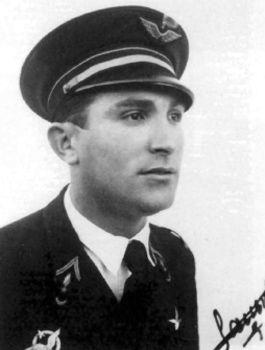
Roger SAUSSOL, GC III/1
Peut-être abattu le 26 mai 1940 à bord d'un MS 406 par Georg SCHNEIDER.
Could have been shot down on 26th May, 1940, on board a MS 406 by Georg SCHNEIDER.
Photo : auteur inconnu - author unknown
Comme évoqué précédemment, c’est au cours de ce « dogfight » que Schneider abattit soit l’avion du lieutenant de Malmann (sautant en parachute, il se fit cueillir au sol par les troupes allemandes), soit l’avion de l’adjudant Saussol à court de munitions qui se posa de justesse dans un champ (blessé à la jambe, Saussol fut également capturé au sol). A court de carburant après ce dernier combat, Schneider dut faire un atterrissage d’urgence sans dommages à Saint-Pol-sur-Ternoise aux mains des Allemands.
As said before, it is during this "dogfight" that Schneider shot down or the aircraft of Lieutenant de Malmann (he bailed out and was captured on the ground by the German troops), or the aircraft of Warrant Officer Saussol, short of ammunitions, who just landed in a field (with a wounded leg, Saussol was also captured on the ground). Out of fuel after this last fight, Schneider had to make an emergency landing without damage at Saint-Pol-sur-Ternoise in the German lines.

Morane-Saulnier MS 406 (n°772, L-801) GC III/1, 2e escadrille, Adj.Kleber Doublet.
Le Plessis-Belleville, France - 26 mai 1940 - May 26th, 1940
© Pierre-Andre Tilley
A la fin de ce mois de mai 1940, Schneider avec 6 victoires homologuées fut classé avec la meilleure note ("1") du JG 21. Sa 7e et ultime victoire fut celle obtenue contre un Bristol Blenheim Mk.IV britannique à 5 km au sud de Soesterberg aux Pays-Bas le 27 juin 1940, combat au cours duquel le Blenheim réussit dans sa chute à l’atteindre également.
At the end of May 1940, Schneider had 6 confirmed victories and was ranked with the highest score ("1") of the JG 21. His 7th and ultimate victory was obtained against a British Bristol Blenheim Mk. IV at 3 miles South of Soesterberg in the Netherlands on June 27th, 1940, but a fight during which the Blenheim, during its fall, could hit him also.
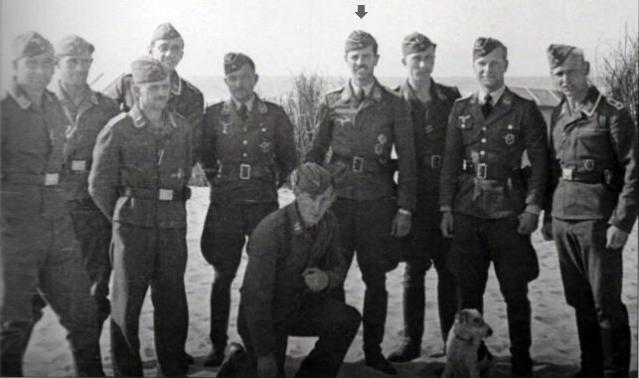
Georg Schneider, 24 juin 1940 - 24th June 1940
Photo : auteur inconnu - author unknown
Tôt ce 27 juin 1940, une formation de bombardiers Bristol Blenheim Mk.IV de la RAF 82 Squadron se dirige à partir de sa base de Watton (Norfolk – GB) pour une mission sur le Nord-Ouest de l’Allemagne. Sur leur vol de retour, vers 16h 15, 3 de ces Blenheim surgissent au-dessus de l’aérodrome allemand de Soesterberg (Pays-Bas) et commencent à cercler au-dessus de la base de la Luftwaffe. Les chasseurs Bf 109 E-1 de la 3./JG 21 décollent aussitôt… Dans le combat aérien qui s’engage, l’Oblt. Schneider abat le Blenheim R3731, UX-Y.
Early in the morning, on June 27th, 1940, a group of bombers Bristol Blenheim Mk. IV of the RAF 82 Squadron flew from its base, Watton (Norfolk - UK) for a mission over North-Western Germany. During their return flight, at about 4:15 pm, 3 of these Blenheim appeared over the German airfield of Soesterberg (Netherlands) and began to circle over the Luftwaffe base. Bf 109 E-1 fighters of her(it) 3./JG 21 took off immediately … In the air combat which started, Oblt. Schneider shot down the Blenheim R3731, UX-Y.
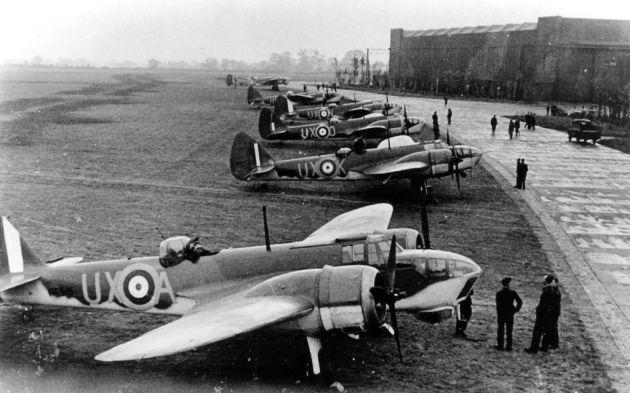
Bristol Blenheim Mk IV, 82 SQN, Watton (UK), 1940
Photo : auteur inconnu - author unknown
Le bombardier britannique s’écrase dans un bois de Woudenbergseweg, près de Zeist (Utrecht), à 12 km au Sud-Ouest de Amersfoort. Deux des membres de l’équipage britannique trouvent la mort : le P/O (Pilot officer – RAF 42640, 82 SQN) Ralph Percy (21 ans) et le mitrailleur (W.Op./Air Gnr. – RAFVR 749331, 82 SQN), le sergent Andrew Clark (22 ans). Le navigateur et observateur, le sergent A.A. Stanley arrive à s’en sortir (fait prisonnier, il survivra au conflit). Durant la chute de son appareil, le mitrailleur Andrew Clark réussit lors d’un dernier échange de tirs à atteindre l’appareil de Georg Schneider qui s’écrase également, à proximité de Zeist.
The British bomber crashed in a wood at Woudenbergseweg, near Zeist (Utrecht), 8 miles South-West of Amersfoort. Two of the British crew members were killed : P/O (Pilot officer - RAF 42640, 82 SQN) Ralph Percy (21 years old) and the machine-gunner (W.Op./Air Gnr. - RAFVR 749331, 82 SQN), Sergeant Andrew Clark (22 years old). The navigator and observer, Sergeant A.A. Stanley was safe (captured, he survived the war). During the fall of his aircraft, the machine-gunner Andrew Clark could during a last exchange of fire fight to hit Georg Schneider's aircraft which also crashed, near Zeist.
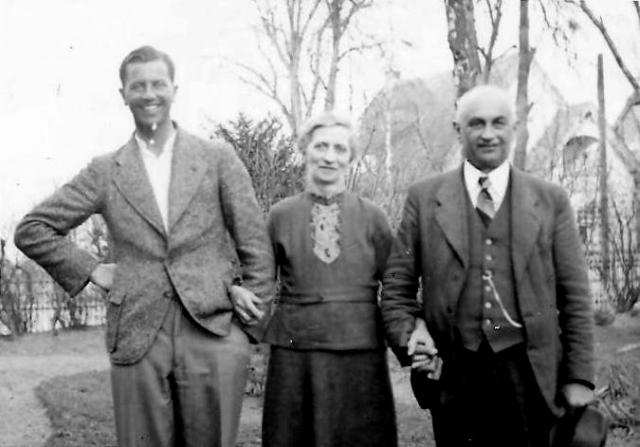
Oberleutnant Georg Schneider © Erik Fechner
Schneider avait lui 26 ans. Il a été de fait le 1er pilote de la JG 21 à avoir été abattu dans le ciel néerlandais et fut inhumé le 28 juin avec les honneurs militaires en présence de toute l’escadre au cimetière de Soesterberg. A sa suite à la tête de la 3. Staffel a été nommé l’Oberleutnant Richard Hausmann, la JG 21 disparaissant peu de temps après pour former le III./JG 54.
Schneider was 26 years old. He was the 1st pilot of the JG 21 who was shot down in the Dutch sky and was buried on June 28th with the military honors in the presence of all the squadron at the cemetery of Soesterberg. He was then replaced at the head of 3.Staffel by the Oberleutnant Richard Hausmann ; the JG 21 disappeared a short time later and became the III./JG 54.

Oberleutnant Georg Schneider : victoires aériennes - aerial victories
Selon certains historiens, Schneider aurait peut-être abattu un second PZL P.11 le 1er septembre 1939.
According to some historians, Schneider would have shot down a second PZL P.11 on September 1st, 1939.
La JagdGeschwader 21
The JagdGeschwader 21
15 juillet 1939 - 06 juillet 1940 - 15th July, 1939 - 6th July, 1940
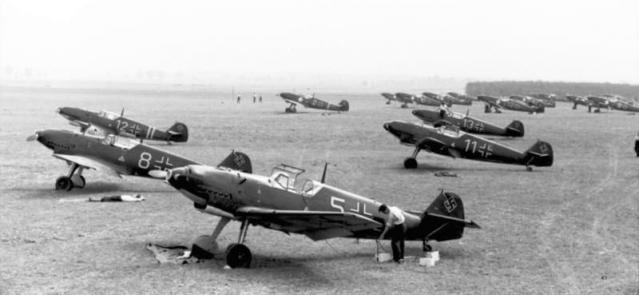
Messerschmitt Bf 109 C & D (B ?)
© Bundesarchiv Bild 101I-379-0015-18 Photographer : Rübelt
(Cette image est soumise aux droits de Creative Commons Attribution ShareAlike 3.0 Germany License)
(This picture is licensed under Creative Commons Attribution ShareAlike 3.0 Germany License)
Suite à un ordre réglementaire du 24 juin 1939, la Jagdgeschwader 21 fut constituée le 15 juillet suivant. Cette création est liée à une réorganisation de la I./JG 1 à laquelle elle était encore subordonnée dans un premier temps. Cette escadre de chasseurs I./JG 21 (il n’y aura finalement qu’un seul « Gruppe ») fut tout d’abord basée à Jesau (province de Königsberg – Prusse-Orientale, aujourd’hui la ville russe de Juschny, près de Kaliningrad), d’où la « Croix de Jesau » ("Jesau Kreuz“) qu’arboraient les avions (et qu’ils conserveront tout au long du conflit même lorsque les unités seront dissoutes et réintégrées dans d’autres escadres comme la JG 54).
According to an official order dated June 24th, 1939, the Jagdgeschwader 21 was created on the next July 15th. This creation is the result of a reorganization of I./JG 1 to which it was still affected at the beginning. This fighter squadron I./JG 21 (in fact there was only one single "Gruppe") was based at first at Jesau (province of Königsberg - Eastern Prussia, today the Russian city of Juschny, near Kaliningrad), which explains the " Cross of Jesau " ("Jesau Kreuz") which was exhibited on the aircrafts (and which was kept throughout the war even when the units were dissolved and dispatched in other squadrons such as the JG 54).
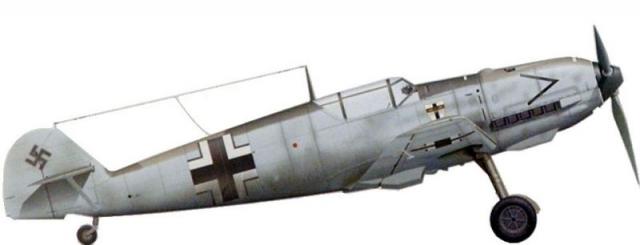
Messerschmitt Bf 109 E-1, I./JG 1 ("Jesau Kreuz")
Auteur inconnu - Author unknown
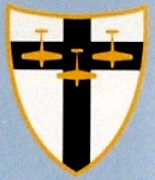

Messerschmitt Bf 109 E-3, I./JG 1 ("Jesau Kreuz")
Auteur inconnu - Author unknown
En prévision du conflit imminent avec la Pologne, la I./JG 21 fut déplacée le 24 juillet 1939 vers un aérodrome de Prusse-Orientale plus au sud (plus proche de la frontière polonaise), à Gutenfeld (aujourd’hui : Lugowoje, près de Kaliningrad, Russie). Dans cette offensive à venir du 1er septembre 1939, la Luftwaffe utilisera deux unités, la "Luftflotte 1 Ost" au nord dont dépend la I./JG 21, sous le commandement du général Albert Kesselring, et la "Luftflotte 4 Südost" sous les ordres du général Alexander Löhr, au sud. Au total, la Luftwaffe engagera un effectif théorique de 342 chasseurs Messerschmitt Bf 109 (320 en état de vol).
To prepare the coming campaign of Poland, the I./JG 21 was moved on July 24th, 1939 towards an airfield in Eastern Prussia further south (closer to the Polish border), at Gutenfeld (today : Lugowoje, near Kaliningrad, Russia). For this offensive to come on September 1st, 1939, the Luftwaffe planned to use two units, the "Luftflotte 1 Ost" in the North which included the I./JG 21, under the command of general Albert Kesselring, and the "Luftflotte 4 Südost" under orders of general Alexander Löhr, in the South. The Luftwaffe commited a total of 342 Messerschmitt Bf 109 fighters (320 in flight condition).
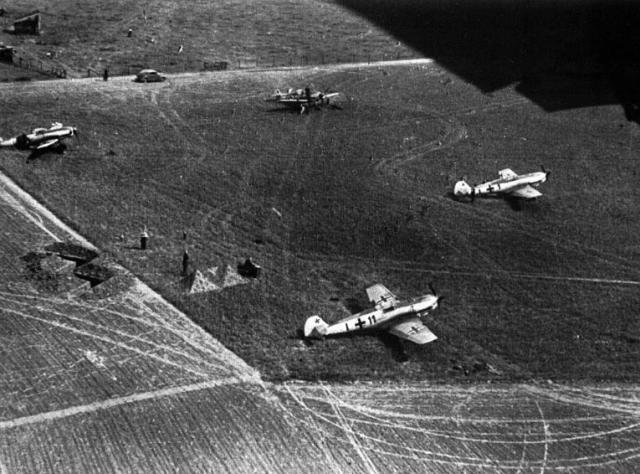
Messerchmitt Bf 109-D & E, JG 1, Jesau
Photo : auteur inconnu - author unknown
Deux escadres étaient encore équipées de Messerschmitt Bf 109 D (Dora), la I./JG 21, commandée par le Hauptmann Martin Mettig, dépendante du "Luftgaukommando I Ostpreußen" au nord , et la I./ZG 2 commandée par le Hauptmann Johannes Gentzen, intégrée dans le "Fliegerführer z.b.V." au sud . A la date du 26 août 1939, la I./JG 21 disposait de 39 Bf 109 D-1 répartis entre trois "Staffeln" : la 1. sous les ordres de l’Oblt. Günther Scholz, la 2. sous ceux de l’Oblt. Leo Eggers et la 3. sous ceux de l’Oblt. Georg Schneider.
Two squadrons were still equipped with Messerschmitt Bf 109 D (Dora), the I./JG 21, commanded by the Hauptmann Martin Mettig, assigned to "Luftgaukommando I Ostpreußen" in the North, and I./ZG 2 under Hauptmann Johannes Gentzen, integrated into "Fliegerführer z.b. V." in the South. On August 26th, 1939, the I./JG 21 had 39 Bf 109 D-1 dispatched in three "Staffeln" : the 1. under orders of Oblt. Günther Scholz, the 2. under Oblt. Leo Eggers and the 3. under Oblt. Georg Schneider.
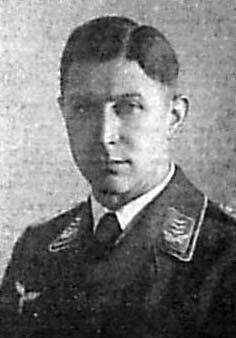
Hauptmann Johannes GENTZEN, 1938
Photo : auteur inconnu - author unknown

Messerschmitt Bf 109 D-1, I./ZG 2, 1939
Auteur inconnu - Author unknown
Les ordres opérationnels de l’opération "Wasserkante“ pour la I./JG 21 sont arrivés à Gutenfeld vers 18h00 le 31 août 1939. Les conditions météorologiques du lendemain 1er septembre, jour de l’agression sur la Pologne, ont empêché l’escadre de participer aux premières offensives déclenchées à 4h30 du matin.
The operational orders of the operation "Wasserkante" for the I./JG 21 were given at Gutenfeld at about 6:00 pm on August 31st, 1939. The weather conditions for the following day September 1st, day of the attack of Poland, prevented the squadron from participating to the first offensives which started at 4:30 am.
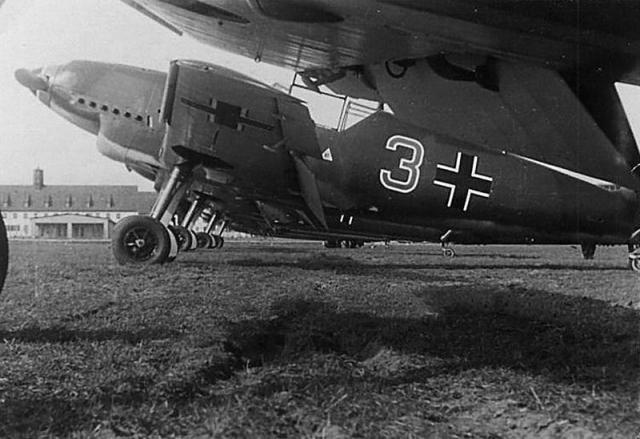
Messerschmitt Bf 109 D-1, 2./JG 21 - “Rot 3”.
Allemagne - Germany
Photo : auteur inconnu - author unknown
La I./JG 21 a reçu l’ordre à midi de se déplacer vers un aérodrome de campagne ("Feldflugplatz") tout près de la frontière, celui d’Arys-Rostken, quelques 130 kilomètres plus au sud et à 175 km au Nord-Nord Est de Varsovie. Les Bf 109D ont décollé de Gutenfeld à 14h20 et se sont posés sur leur nouvelle base une demi-heure plus tard, un avion de transport Ju-52/3m les suivant peu après avec les mécaniciens et les armuriers de l’unité.
The I./JG 21 received the order at noon to move towards an airfield ("Feldflugplatz") very close to the border, called of Arys-Rostken, some 80 miles further south and 110 miles North-North East of Warsaw. The Bf 109Ds took off from Gutenfeld at 2:20 pm and landed on their new base half an hour later, and a transport aircraft Ju-52/3m followed them shortly after with the mechanics and the armourers of the unit.
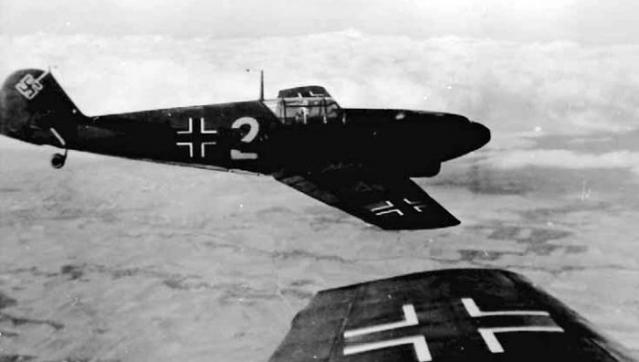
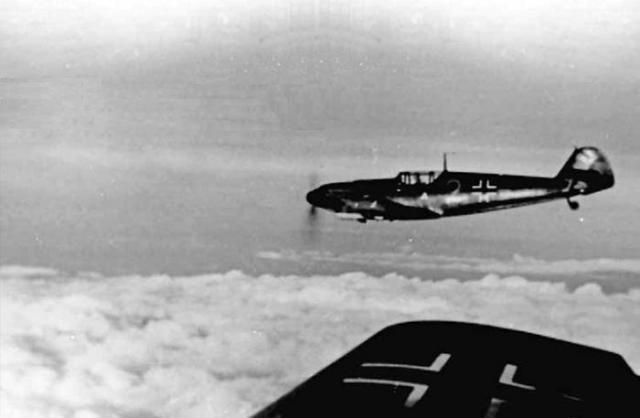
Messerschmitt Bf 109 D-1, 1./JG 21 - “Weiss 2”, 1. Staffel - “Gelbe 2”, 3. Staffel.
Prusse Orientale - Eastern Prussia
Photo : auteur inconnu - author unknown
L’aérodrome de Rostken près de Arys (aujourd’hui Orzysz Rostki, Pologne) a été construit pendant deux ans à partir de 1936 dans le plus grand secret pour devenir une des principales bases de la Luftwaffe en Prusse-Orientale. Dans une région pauvre et ingrate pour l’agriculture, l’achat d’un terrain marécageux sur les bords du lac Rosch See a été une aubaine pour les habitants à qui on a fait croire que le futur "Feldflugplatz" était destiné à l’aéro-club de Johannisburg ! En outre de nombreux habitants ont trouvé un emploi dans la construction de l’aérodrome. Les travaux ont duré jusqu’en 1938.
Rostken airfield, near Arys (today Orzysz Rostki, Poland) was built within two years from 1936 in secret, to become one of the main bases of Luftwaffe in Eastern Prussia. In a poor and ungrateful region for the agriculture, the purchase of a marshy ground on the shores of the Lake Rosch See was a chance for the inhabitants whom were told that the future "Feldflugplatz" was intended for Johannisburg's flying club ! Moreover many people found a job in the construction of the airfield. The works lasted until 1938.
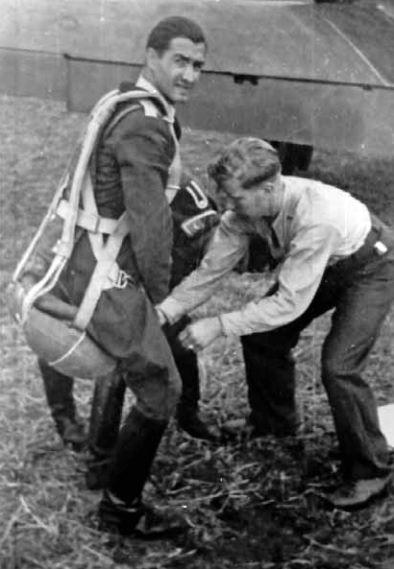
Günther Scholz, Staffelkapitän de la 1./JG 21, Arys-Rostken
1er septembre 1939 - 1st September 1939
Photo : auteur inconnu - author unknown
Le site a tout d’abord été drainé puis transformé en terrain d’aviation, en prévision pour la Luftwaffe de la guerre à l’Est (Arys-Rostken sera une des principales bases de l’aviation allemande lors de l’attaque de la Pologne en 1939 ou celle de l’URSS en 1941). Le secret sur la finalité militaire des aménagements, tant auprès de la population allemande locale que face à d’éventuelles observations aériennes, a été bien tenu : la I./JG 21 n’y a été déplacée que le jour même de l’attaque contre la Pologne, le terrain est resté longtemps en herbe et les divers bâtiments (garnison, pilotes et mécaniciens, hangars, administration, intendance) avaient l’apparence de simples maisons de village, éparpillés et largement dissimulés par la forêt environnante. La tour de contrôle elle-même a été construite entre de grands pins sur la colline du cimetière local.
The site was first drained and then transformed into an airfield, for the Luftwaffe to be ready for the war in the East (Arys-Rostken has been one of the main bases of the German aviation then during the attack of Poland in 1939 and USSR in 1941). The secret on the military purpose of the infrastructures, both for the local German population or for possible aerial observations, was well kept : the I./JG 21 was moved there only the very first day of the attack against Poland, the runway remained grassy for a long time and the various buildings (garrison, pilots and mechanics, sheds, administration, supply management) looked like simple village houses, dispatched and widely hidden by the surrounding forest. The control tower itself was built between tall pines on the hill of the local cemetery.
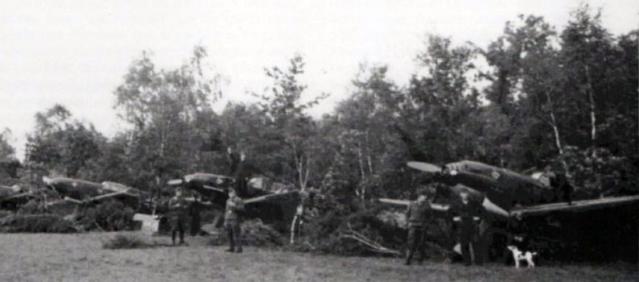
Messerschmitt Bf 109D, 3./JG 21

Sur cette photo à la frontière germano-polonaise (probablement à Arys-Rostken), on distingue l’écusson de la 3. Staffel, un "faucon plongeant" sur fond de nuage …
On this picture taken at the German-Polish border (probably Arys-Rostken), we can see the shield of 3. Staffel, a "diving falcon" throughout the clouds...
Photo : auteur inconnu - author unknown
Par la suite (1943), trois pistes en béton (2000 mètres de longueur sur 20 mètres de large) ont été construites : elles se fondaient avec le réseau routier local et des filets de camouflage couvraient les bords des pistes, de telle sorte que, vues du ciel, elles apparaissaient toujours comme de simples routes (entraînant quelques difficultés pour les pilotes novices à retrouver le terrain après leur première sortie au-dessus de Varsovie dans l’après-midi du 1er septembre 1939 !). Un taxiway circulaire forestier, caché lui aussi par des filets, permettait de relier efficacement les pistes.
Later (1943), three concrete (6,500 ft long, 65 ft wide) were built : they were indistinguishable from the local road network and some camouflage netting were covering the edges of runways, so that from the sky, they always looked like single roads (wich involved some difficulties for the inexperienced pilots to find the airfield after their mission over Warsaw the afternoon of September 1st, 1939 !). A circular taxiway, hidden too with nets in the forest, allowed to reach the runways.
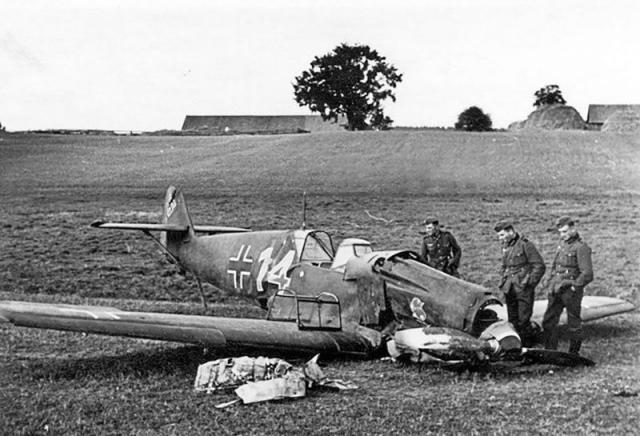
Messerschmitt Bf 109 D-1, 2.JG21 "Rot 14", Walter Nuhr
6 septembre 1939 - 6th September 1939
Photo : auteur inconnu - author unknown
En cas de nécessité, les routes étaient fermées au trafic automobile. L’aérodrome a encore intensément servi à la défense de la Prusse-Orientale de mai 1944 jusqu’à janvier 1945. A leur départ, les troupes allemandes ont détruit la plupart des infrastructures de l’aérodrome de Rostken. Seules sont encore visibles aujourd’hui quelques fondations en béton et l’anneau circulaire en béton du taxiway.
When necessary, roads were closed to the car traffic. The airfield has still been used intensively for the defense of Eastern Prussia from May, 1944 till January, 1945. When they left, the German troops destroyed most of the infrastructures of Rostken airfield. Today, some concrete foundations and the concrete circular ring of the taxiway can still be seen.
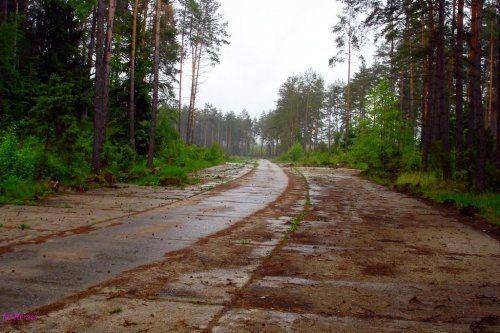
Arys-Rostken
Photo : auteur inconnu - author unknown
A l’issue de la campagne de Pologne, la JG 21 fut déplacée en octobre 1939 à Plantlünne/Wesel (Basse-Saxe). L’escadre est alors placée sous les ordres de l’état-major de la JG 27. La JG 21 est chargée de la défense aérienne du nord-ouest du Reich allemand. Le même mois commence le remplacement des « Dora » par des Bf 109 E-1 et E-3, achevé en novembre 1939.
After the Polish campaign, the JG 21 was moved in October, 1939 to Plantlünne/Wesel ( Lower Saxony). The squadron was then placed under the orders of the JG 27's general staff. The JG 21 was in charge of the air defense of north-western German Reich. The same month began the replacement of the "Doras" by Bf 109 E-1s and E-3s, which finished in November, 1939.
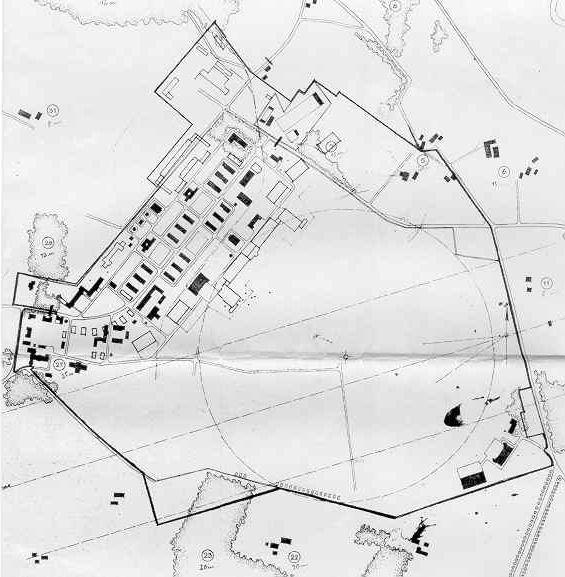
Münster-Handorf airfield, 1938
Toujours en novembre, la JG 21 est déplacée à Hopsten (Rhénanie-du-Nord-Westphalie) puis le mois suivant, à Krefeld puis Münster-Handorf (Westphalie), aérodrome de remplacement de Münster-Loddenheide. Théoriquement équipée de 39 appareils, la JG 21 dispose au 2 décembre 1939 de 33 Bf 109 E et encore 1 Bf 109 D (31 appareils prêts au combat).
In November again, the JG 21 moved to Hopsten (North Rhine-Westphalia), then the next month, to Krefeld then again to Münster-Handorf (Westphalia), airfield which replaced Münster-Loddenheide. In theory equipped with 39 aircrafts, the JG 21 had on December 2nd, 1939 33 Bf 109 Es and one Bf 109 D (31 aircrafts in flight condition).
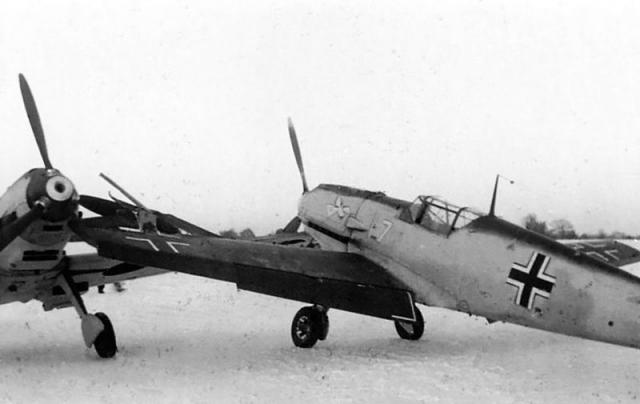
Messerschmitt Bf 109 E-1, 1.JG21 "Weiss 7", Munster-Loddenheide
Accident au roulage - Taxiing accident
Photo : auteur inconnu - author unknown
Au début de l’année 1940, la JG 21 se trouve toujours à Münster-Handorf. En liaison avec la JG 27, l’escadre prend part à la campagne occidentale à partir du 10 mai 1940. Les 1ers jours de guerre amenèrent la JG 21 à se battre essentiellement dans les secteurs de Eben-Emael (province de Liège – Belgique) et de Maastricht (Pays-Bas). Le 12 mai, l’escadre fut déplacée à l’aérodrome de campagne de Vogelsang (Rhénanie-du-Nord-Westphalie) d’où elle fut engagée au-dessus de Sedan et Charleville. Le 16 mai, la JG 21 s’installe sur l’aérodrome de campagne de Neufchâteau (Vosges) puis progressivement sur d’autres aérodromes vers l’ouest en appui des troupes blindées au sol.
In early 1940, the JG 21 was still at Münster-Handorf. In conjunction with the JG 27, the squadron took part in the western campaign from May 10th, 1940. The first days of war led the JG 21 to fight mostly in the regions of Eben-Emael (province of Liege - Belgium) and Maastricht (Netherlands). On May 12th, the squadron moved to the airfield of Vogelsang (North Rhine-Westphalia) from where it was committed over Sedan and Charleville (France). On May 16th, the JG 21 reached the airfield of Neufchâteau (Vosges - France) then gradually other airfield westward to support of the armoured troops in the field.
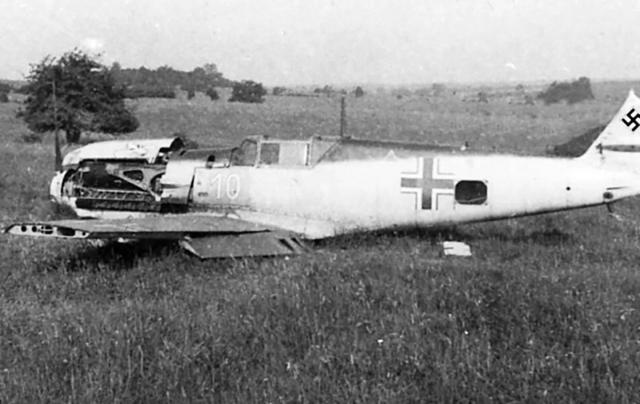
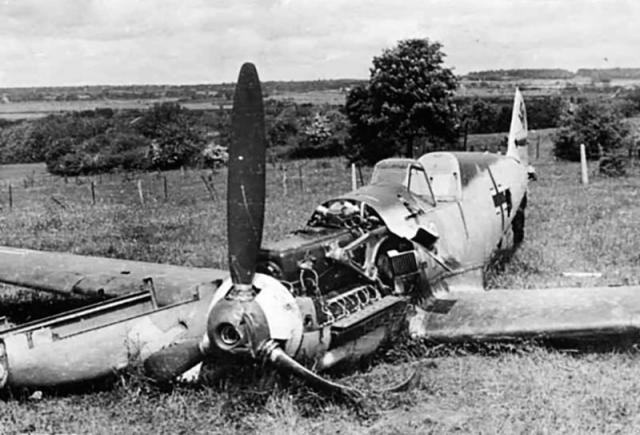
Messerschmitt Bf 109 E-1, 1.JG 21 "Weiss 10", Holland
Juin 1940 - June 1940
Photo : auteur inconnu - author unknown
Entre le 22 et le 26 mai 1940, l’escadre fut engagée dans de rudes combats aériens dans le secteur de Cambrai. Basés semble-t-il à Vitry-en-Artois, les pilotes sont en appui du 1er au 4 juin des troupes de la Wehrmacht sur la Basse-Somme. Transférée à GentSaint-Denis le 4 juin 1940, la JG 21 se détache alors de la JG 27 sans que l’on ne sache très bien sous quel commandement elle passe alors. Jusqu’à la mi-juin, la JG 21 est positionnée à plusieurs endroits au sud de Paris (dont Orly) et le 22 juin, l’escadre est retirée de France pour revenir à Mönchengladbach (Rhénanie-du-Nord-Westphalie). Dès le lendemain, elle se redéploie aux Pays-Bas à Soesterberg où elle s’acquitte de missions de défense aérienne au-dessus des côtes néerlandaises.
Between May 22nd and 26th, 1940, the squadron was committed in hard dogfights in the region of Cambrai. Based probably at Vitry-en-Artois, the pilots used to support from 1st till 4th June the Wehrmacht troops on southern part of the department of the Somme (France). Moved to Gent-Saint-Denis on June 4th, 1940, the JG 21 left the JG 27 but no-one knows exactly under which command it was then. The first two weeks of June, the JG 21 moved to various airfields in the Southern region of Paris (including Orly) and on June 22nd, the squadron was removed from France and returned to Mönchengladbach (North Rhine-Westphalia). The following day, it moved in the Netherlands to Soesterberg where it was in charge of aerial defense missions over the Dutch coast.
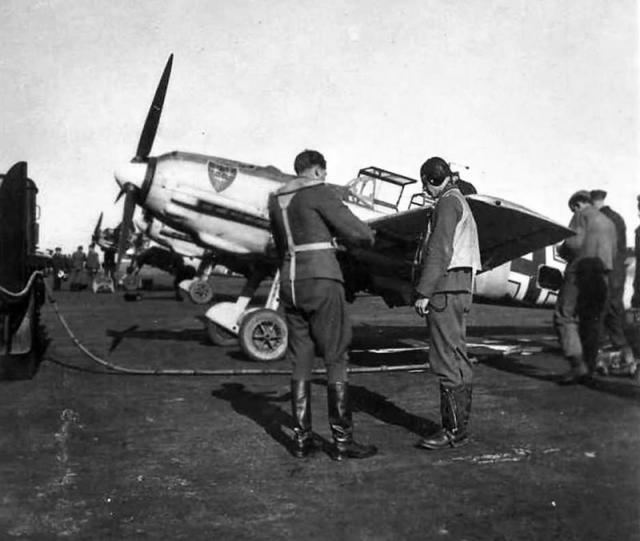
Messerschmitt Bf 109 E-4, JG 21 > JG 54
Photo : auteur inconnu - author unknown
Durant la campagne occidentale, la JG 21 a été créditée de 45 victoires aériennes tandis qu’elle-même comptait 3 pilotes tués, 1 prisonnier, 1 pilote blessé et 10 Bf 109 détruits. A Soesterberg, la I./JG 21 passa sous le commandement de la JG 54. A partir de son redéploiement à Bergen-op-Zoom le 5 juillet 1940, elle fut dès le lendemain définitivement intégrée au sein de la JG 54 "Grünherz" dont elle forme dès lors le III.Gruppe (III./JG 54) conservant sa "Jesau Kreuz“, la 3./JG 21 devenant la 9./JG 54 et adoptant dès lors le "Diable grimaçant" de Hans-Ekkehard Bob en lieu et place du "Faucon plongeant".
During the western campaign, the JG 21 was credited of 45 aerial victories but accounted 3 pilots killed, 1 prisoner, 1 pilot injured and 10 Bf 109s destroyed. At Soesterberg, the JG 21 was affected to the JG 54. When it moved to Bergen-op-Zoom on July 5th, 1940, it was from the next day definitively integrated in the JG 54 "Grünherz" and became then the III.Gruppe (III./ JG 54), keeping its "Jesau Kreuz". The 3./JG 21 became the 9./JG 54 and adopted the "grinning Devil" from Hans-Ekkehard Bob to replace the "diving falcon".
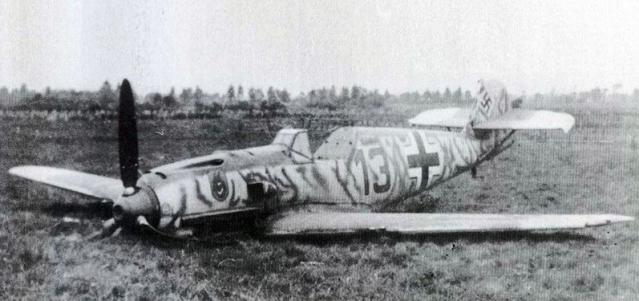
Messerschmitt Bf 109 E-4, "Gelbe 13" 9./JG 54, Leutnant Josef Eberle
Hollande - Holland 1940
Photo : auteur inconnu - author unknown
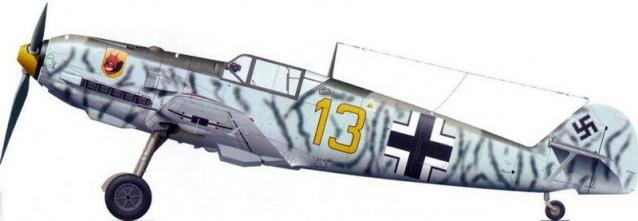
Messerschmitt Bf 109 E-4, "Gelbe 13" 9./JG 54
Artiste inconnu - artist unknown
Les 109 de Georg Schneider en maquette
Georg Schneider's 109 in model kits

Messerschmitt Bf 109 D-1 & Bf 109 E-1, 3./JG 21, Oblt. Georg Schneider
© Erik Fechner
Comme évoqué en préambule, Georg Schneider était le grand-oncle d'Erik Fechner, membre fondateur du forum de maquettistes Fighters, mais aussi et surtout maquettiste de grand talent. Il était donc naturel qu'Erik réalise les Messerchmitt Bf 109 de son grand-oncle. Il choisit pour l'occasion l'échelle 1/32°. Voici donc successivement le Me Bf 109 D-1 et le Me Bf 109 E-1 de l'Oberleutnant Georg Schneider de la 3./JG 21.
As said in the introduction, Georg Schneider was the great-uncle of Erik Fechner, founder and member of the model-makers forum Fighters, but also and above all a great model kit maker. It was therfore natural that Erik realizes the Messerchmitt Bf 109s of his great-uncle. He chose for the occasion the scale 1:32. Please find below successively the Me Bf 109 D-1 and Me Bf 109 E-1 of Oberleutnant Georg Schneider from 3./JG 21.
Messerschmitt Bf 109 D-1, 1/32°
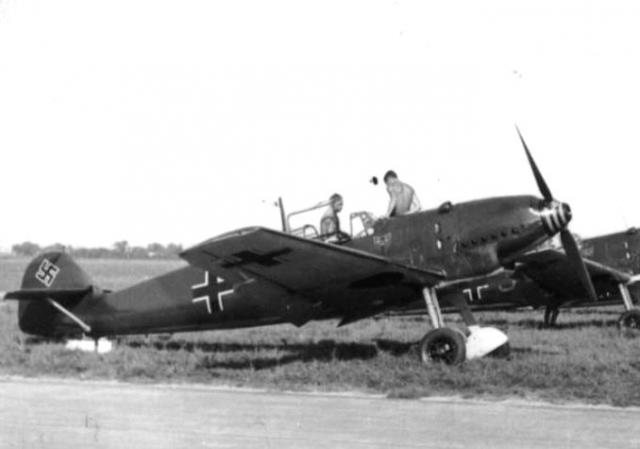
Messerschmitt Bf 109 D-1, 3./JG 21, Oblt. Georg Schneider
Photo : auteur inconnu - author unknown
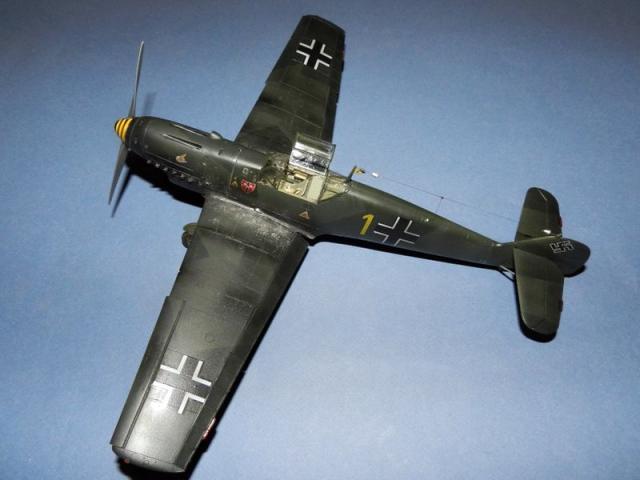
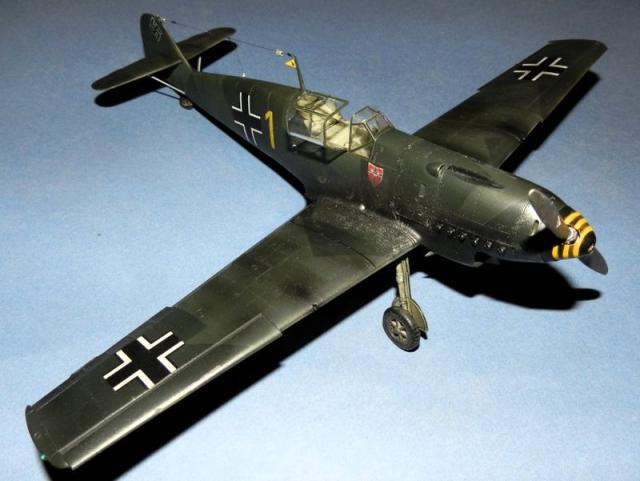
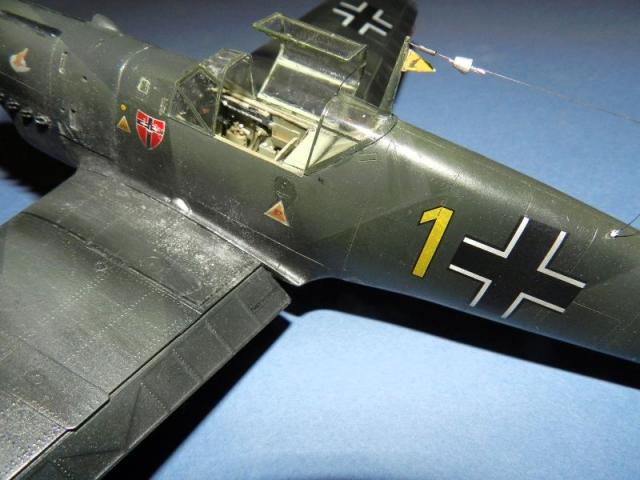
Messerschmitt Bf 109 D-1, 3./JG 21, Oblt. Georg Schneider
© Erik Fechner
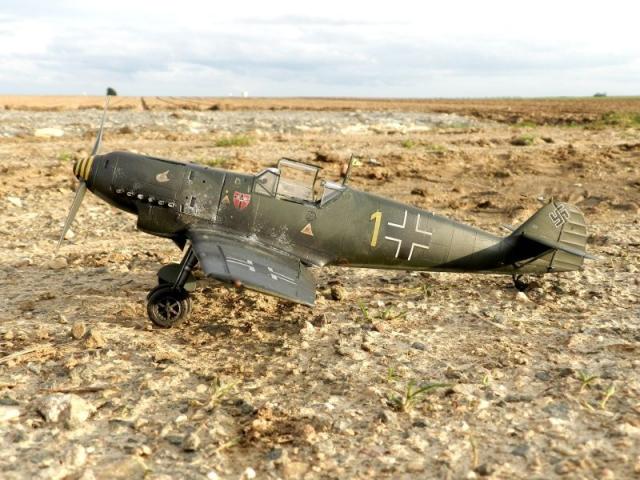
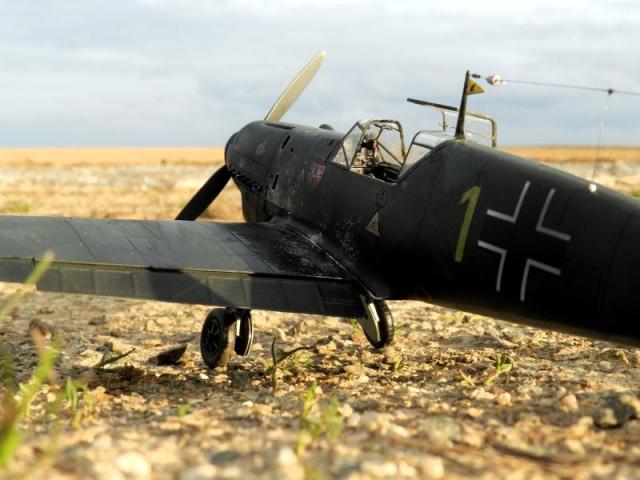
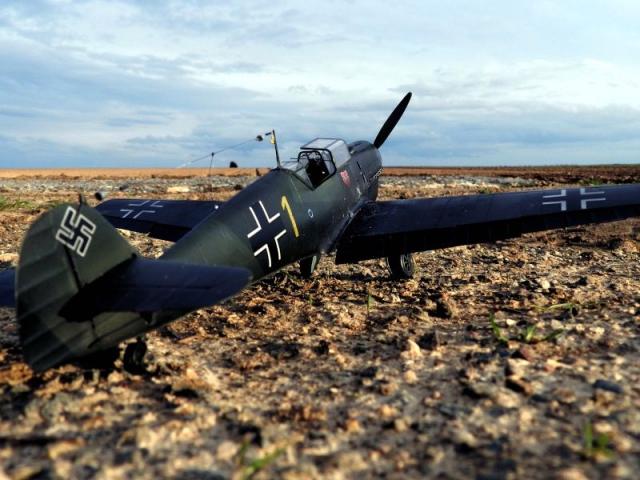
Messerschmitt Bf 109 D-1, 3./JG 21, Oblt. Georg Schneider
© Erik Fechner
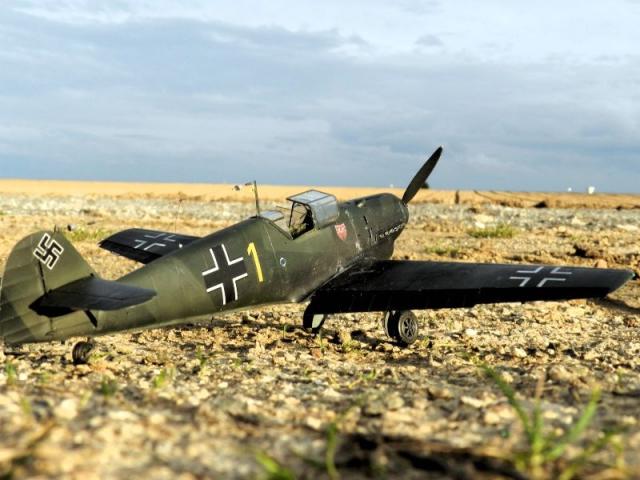
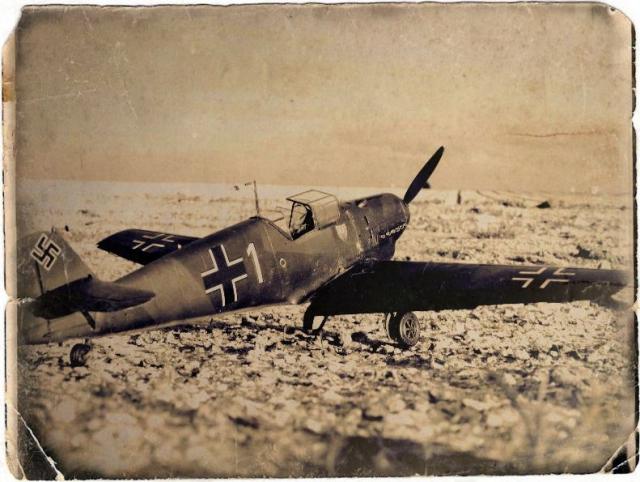
Messerschmitt Bf 109 D-1, 3./JG 21, Oblt. Georg Schneider
© Erik Fechner

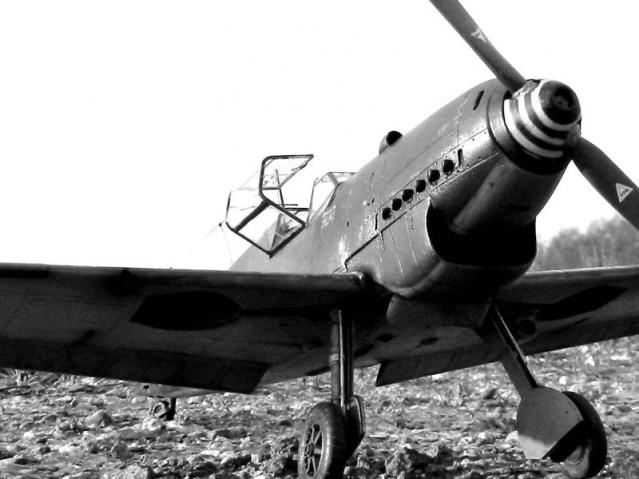
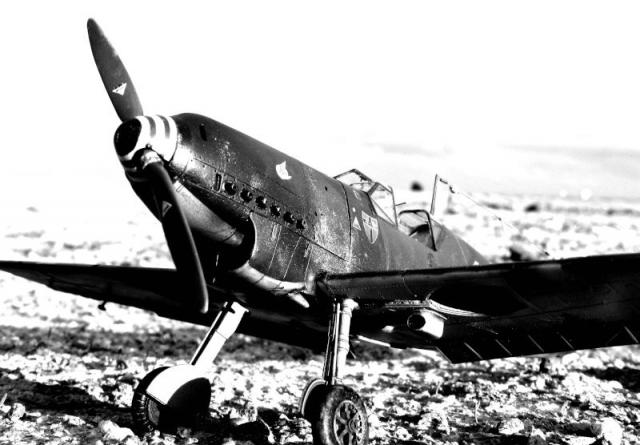
Messerschmitt Bf 109 D-1, 3./JG 21, Oblt. Georg Schneider
© Erik Fechner
Messerschmitt Bf 109 E-1, 1/32°
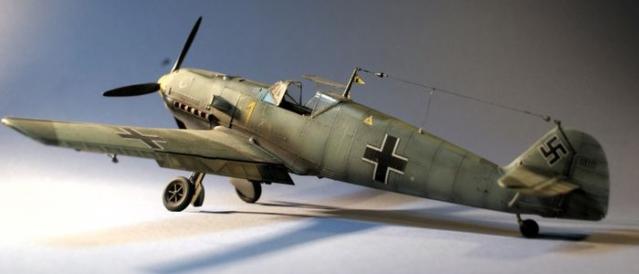
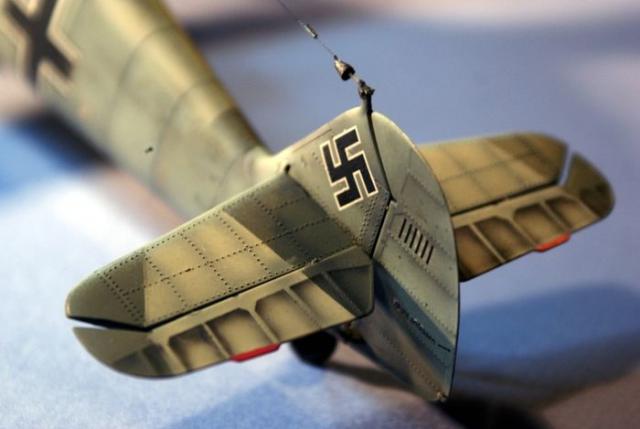
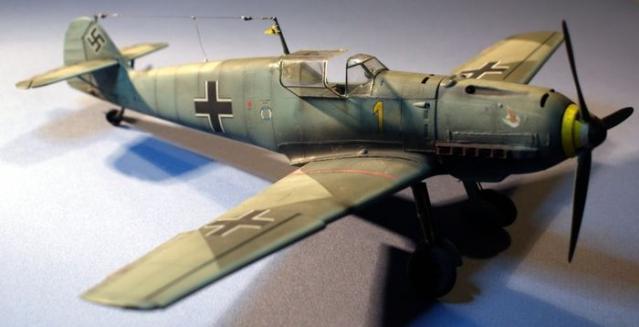
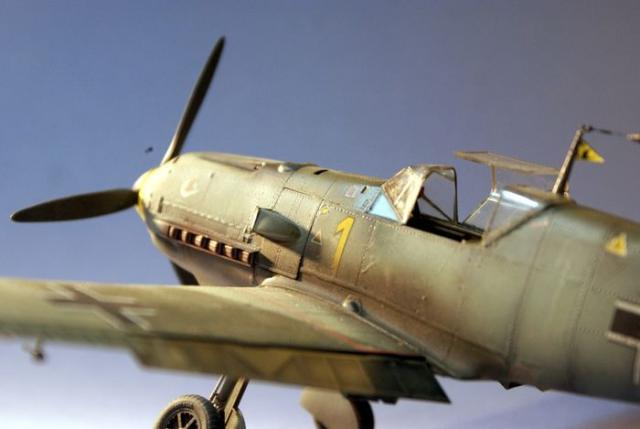
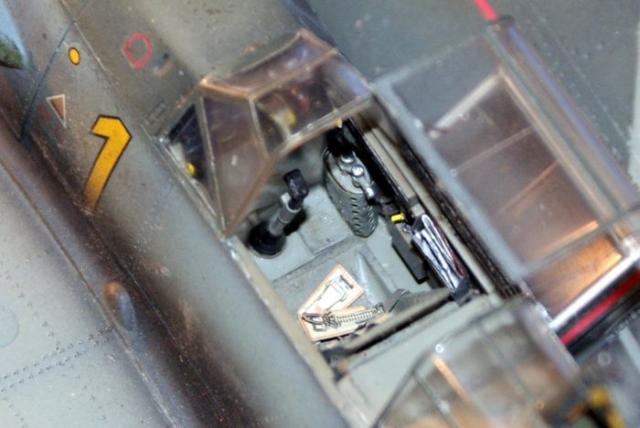
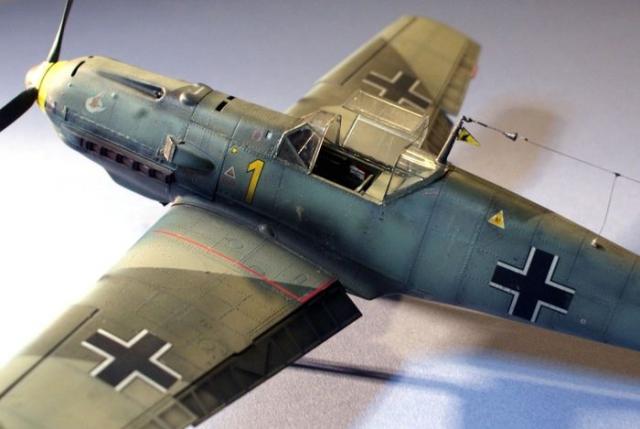
Messerschmitt Bf 109 E-1, 3./JG 21, Oblt. Georg Schneider
© Erik Fechner
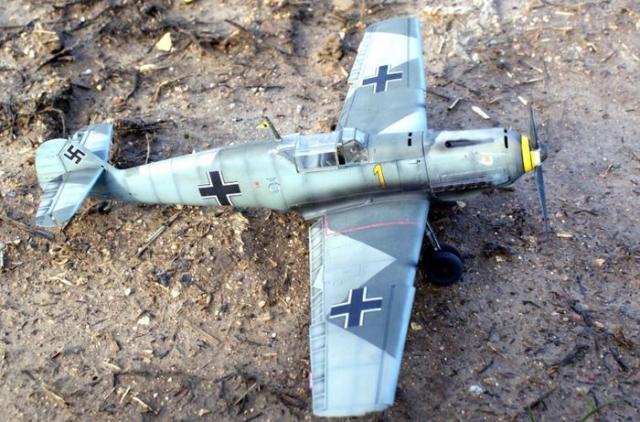
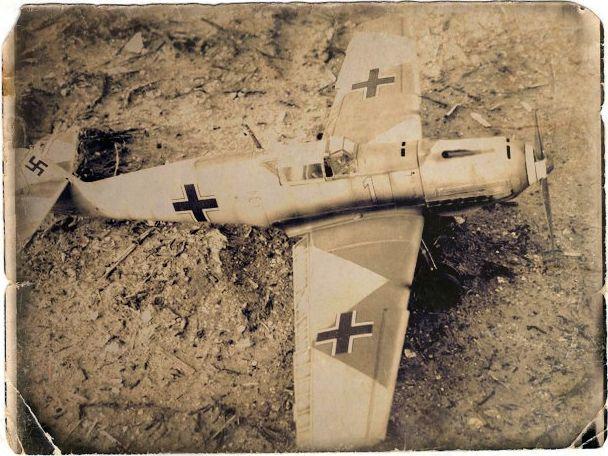
Messerschmitt Bf 109 E-1, 3./JG 21, Oblt. Georg Schneider
© Erik Fechner
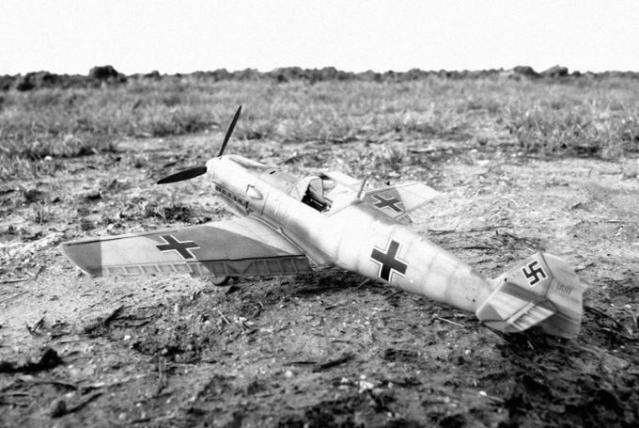
Messerschmitt Bf 109 E-1, 3./JG 21, Oblt. Georg Schneider
© Erik Fechner
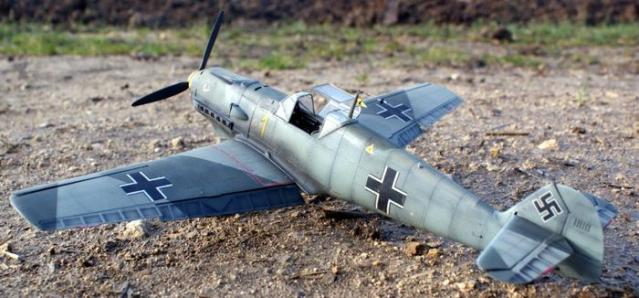
Messerschmitt Bf 109 E-1, 3./JG 21, Oblt. Georg Schneider
© Erik Fechner





